#Andrew Mellon Importance
Explore tagged Tumblr posts
Text
Andrew Mellon
Andrew Mellon: The Financier, Philanthropist, and Political Figure of the 20th Century Andrew Mellon was a distinguished financier, philanthropist, and political figure who played a crucial role in the shaping of American fiscal policy during the early 20th century. He was respected for his financial acumen, which helped him build an extensive business empire. His considerable influence extended…
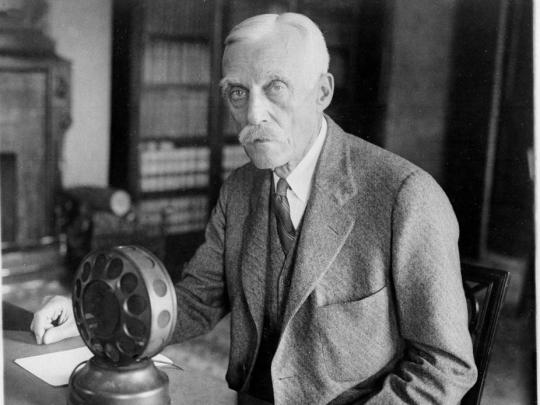
View On WordPress
#Andrew And Richard Mellon#Andrew Carnegie Mellon University#andrew mellon#Andrew Mellon Accomplishments#Andrew Mellon Captain Of Industry#Andrew Mellon Company#Andrew Mellon Definition#Andrew Mellon Economics#Andrew Mellon Education#Andrew Mellon Foundation#Andrew Mellon Foundation Endowment#Andrew Mellon Importance#Andrew Mellon Industry#Andrew Mellon Information#Andrew Mellon Interesting Facts#Andrew Mellon Organization#Andrew Mellon Related To Carnegie#Andrew Mellon Significance#Andrew Mellon Us History#Andrew Mellon Us History Definition
0 notes
Text
My Summer as a Conservation Intern
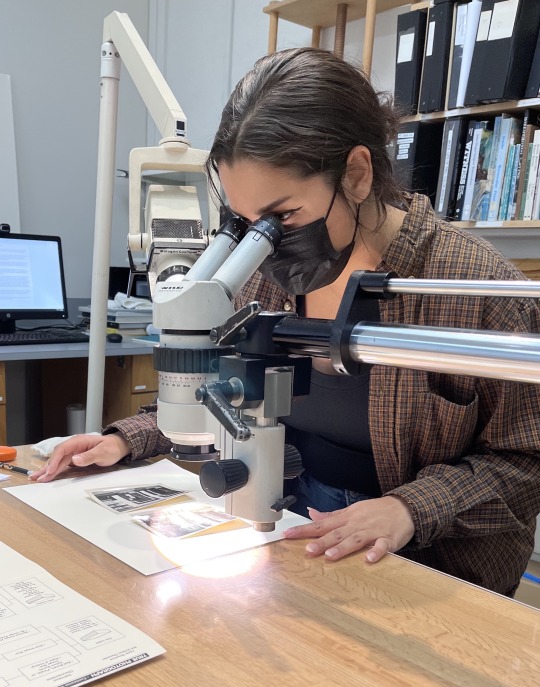
I’m Carolina Benitez, and this summer I was the conservation intern at the Brooklyn Museum. As a pre-program intern, getting experience in the field can be particularly difficult, and it’s hard to decide which specialty you’re most interested in without having the proper experience first. Working at one of the oldest conservation labs in the US was an incredible experience, and having an open lab meant that conservators working in different specialties work within the same space, making collaboration within the department more feasible.
Through the support of the Andrew W. Mellon Opportunity for Diversity in Conservation Program, I was able to be placed to work at the Brooklyn Museum to properly develop my skills through a variety of projects under several supervisors.

Under the direction of our head of conservation Lisa Bruno, I worked in Objects Conservation with project conservator Celeste Mahoney in order to treat 18th century Rajasthani sandstone balcony pieces to ensure their preparation for our fall exhibition. Removing mortar and inpainting these pieces was incredibly fun, and gave me the opportunity to utilize and develop my skills in manual dexterity and color theory.
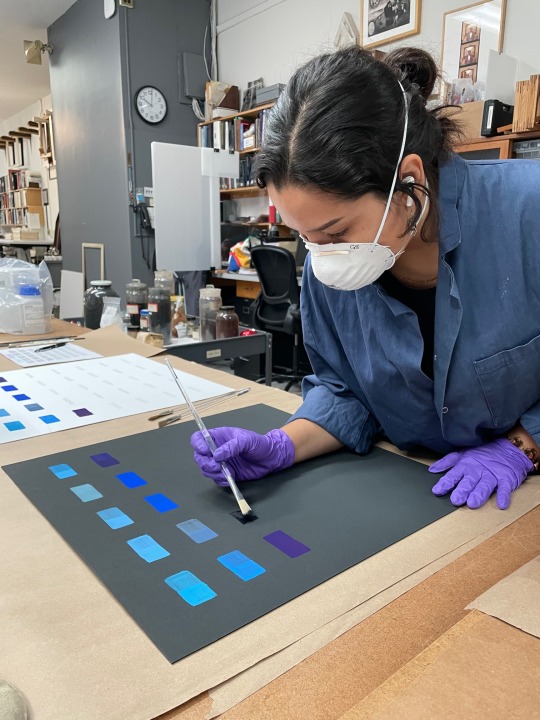
In Paintings Conservation, we worked with Mellon Fellow Isaac Messina to create a database of paint swatches from the lab’s pigment collection in order to create a record for further research through technical photography and multiband imaging. I learned how to make paint with deionized water and rabbit skin glue and got to help with photography to learn more about properties within certain pigments.

For my favorite project this summer, I got to examine and carry out treatment of a gelatin silver photograph; a portrait of sculptor William Edmonson by the photographer Consuelo Kanaga. With Associate Paper Conservator Elyse Driscoll, I was able to treat the photograph’s cracked surface with 1% photo grade gelatin. Afterwards, I conducted a dry cleaning of smudging on the surface of the mount with a kneaded eraser, a vinyl eraser, and vinyl eraser crumbs. Finally, I was able to work on the back of the mount in order to remove residual linen tape with 4% methyl cellulose as a poultice.
The most rewarding part of these projects is getting to have a direct hand in preserving important pieces of art history. As an art historian and a museum lover, I feel that learning and seeing objects and artworks can be fulfilling in itself. The most rewarding aspect of this career is knowing that your preservation ensures the protection of history and knowledge for future generations. After my internship, I can say that my experience at the Brooklyn Museum exceeded my expectations, and I am more adequately prepared for my next chapter.
Posted by Carolina Benitez, Conservation Intern
#brooklyn museum#bkmeducation#internship#new york city#nyc#brooklyn#museum#intern#art#conservation#bkmconservation
9 notes
·
View notes
Text
Comanchero gang raids: President's brother pleads guilty

Vetekina Naufahu joins two other senior members of the Comanchero motorcycle gang in admitting charges of money laundering and participating in an organised criminal group following the covert police investigation Operation Nova.
Once nothing more than a mystery caller on the end of the phone line, the man who smuggled methamphetamine from Mexico into New Zealand for the Comancheros gang will now serve a long prison sent...
A senior Comanchero gang member has admitted charges of money laundering and participating in an organised criminal group, just weeks before his trial was due to start.
Vetekina Naufahu pleaded guilty to three charges at a High Court hearing this morning, held by audio-visual link because of the Covid-19 lockdown in Auckland.
The money laundering charge relates to his late-model Range Rover, worth around $150,000, while the organised crime charge carries the most significant penalty of up to 10 years in prison.
Naufahu - whose brother Pasilika is the president of the New Zealand chapter of the Australian motorcycle gang - also pleaded guilty to possession of MDMA, or Ecstasy, which is a Class-B controlled drug.
Justice Sally Fitzgerald convicted Naufahu of the three offences and scheduled a sentencing date of October 23, 2020, alongside his fellow Comanchero Jarome Fonua.

Last week, the gang's treasurer Fonua also pleaded guilty to money laundering and participating in an organised criminal group.
The late admissions come shortly before the pair were due to stand trial at the High Court in September, along with other members of the gang and their associates on charges laid in April 2019 following Operation Nova.
Vetekina and Fonua now join Tyson Daniels, the gang's vice-president, and Auckland lawyer Andrew Simpson in being convicted of laundering criminal profits.
Nearly $1.3 million in cash was deposited into the lawyer's trust account, which was then used to purchase expensive cars and property.
For Daniels alone, there were four Range Rovers - with price tags of $175,000, $255,000, $218,000 and $280,000 - a $200,000 Mercedes-Benz, a Lamborghini for $285,000, and two Rolls-Royces, which cost $364,000 and $595,000.

A charge of participating in an organised criminal group between May 2017 and April 2019 was also admitted by Daniels, who was living in the affluent Auckland suburb of Mellons Bay until his arrest in April last year.
In sentencing Daniels - who was wearing a Versace top in Comanchero colours of black and gold - to four years and eight months in prison, Justice Gerard van Bohemen said the senior gang member played a crucial role overseeing the gang's operations for significant personal gain.
The offending was sophisticated, said Justice van Bohemen, with encrypted devices used to avoid detection by police.
Money was deposited at banks in amounts less than $10,000, in a bid to avoid triggering the banks' reporting threshold, then funnelled through trust and company accounts to disguise their criminal origins.
"You clearly knew the money was derived from significant importation of drugs."
More than $1.2m in cash was deposited into Simpson's trust account at his law practice, which was also used to purchase some of the cars belonging to Daniels and allegedly others in the gang, as well as real estate such as a $1.3m home in Auckland.
Justice van Bohemen said Simpson was the facilitator of the money-laundering scheme, who used his specialist skills and knowledge as a lawyer.
"You made it work. You set up the trusts and lent respectability, as a lawyer, to a criminal organisation."
Simpson was reckless and brought the legal profession into disrepute, however, the judge was satisfied he was genuine in his remorse.
Despite this, Simpson was sentenced to two years and nine months in prison.
"I deeply regret a father being separated from his family. However, that is a consequence of your decisions."
Neither man was charged with drug offences.

But the police allege the Comanchero, an Australian gang which set up shop in New Zealand after a number of senior members were deported here, are behind significant drug smuggling linked to a Mexican cartel.
In July, a 60-year-old man who travelled to Mexico was sentenced to 16 years in prison after pleading guilty to four charges of importing a Class A drug after being identified in Operation Nova.
Tallat Rahman, from Suva, was arrested in February 2019 in the first phase of the inquiry, which discovered how parcels of methamphetamine weighing up to 5kg were hidden inside kitchen appliances shipped from the United States.
Once in New Zealand, the police allege the drugs were distributed by "frontmen" for the Comanchero, whose hierarchy allegedly reaped the rewards of the illicit trade.
Rahman was unknown to the team of detectives running Operation Nova until he was overheard talking to one of the "frontmen", who cannot be named for legal reasons, whose phone conversations were bugged by police.

He said: "You're going to start off with a nice number with two zeroes. I'm going to land it between you and me ... [I'll give you] all the f***en work you can handle. We're going to land it there [in New Zealand]."
The cheap wholesale price of $120,000 per kilogram was agreed to by both parties, in a deal the police believed would weigh at least 100kg ("a nice number with two zeros").
The call was made in Mexico and the caller was identified as Rahman; a Fijian-Indian who lived in Suva, who had dual Canadian citizenship and travelled regularly to Mexico and the United States.
Everything went quiet until Rahman flew into Auckland International Airport on December 18, 2018, and checked into a hotel on Queen St, the Four Points by Sheraton.
Three days later, Rahman's son checked into the same hotel and was seen meeting with another man, a 19-year-old Mexican national, who also cannot be identified for legal reasons.
Two days before Christmas, December 23, 2018, Rahman left New Zealand but not before receiving a backpack full of cash.
Around the same time, a consignment of a kitchen stovetops shipped from the United States had been seized by Customs and examined. There was nearly 5kg of methamphetamine inside.
Then in February 2019, two separate consignments from the United States - a "waffle maker" and "coffee brewer"- were stopped at the border by Customs, each containing 2.9kg of methamphetamine.

Rahman returned to New Zealand and was arrested by the National Organised Crime Group, along with the 19-year-old from Mexico and a 33-year-old Chinese man called Hui Wang. He was called the "Wire Guy" because he laundered hundreds of thousands of dollars in cash in wire transfers overseas.
Search warrants were also executed at the home linked to Rahman in Suva where Fijian Police discovered 39kg of cocaine, presumably destined for the Australian and New Zealand markets. The haul was worth about $20m.
When brought in for questioning by police, Rahman claimed to be in New Zealand on holiday.
When detectives told him that an audio device had been covertly installed in his hotel room on Queen St, Rahman said: "Oh shit".
1 note
·
View note
Text
Comanchero gang raids: Jarome Fonua pleads guilty to money laundering, participating in an organised criminal group
A senior Comancheros gang member has admitted charges of money laundering and participating in an organised criminal group - changing his plea just a few weeks ahead of his trial. Jarome Fonua entered guilty pleas to the offences this morning at a High Court hearing, held by audio-visual link because of the Covid-19 lockdown in Auckland.
Once nothing more than a mystery caller on the end of the phone line, the man who smuggled methamphetamine from Mexico into New Zealand for the Comancheros gang will now serve a long prison
Vetekina Naufahu joins two other senior members of the Comanchero motorcycle gang in admitting charges of money laundering and participating in an organised criminal group following the covert police investigation Operation Nova. A senior Comanchero gang member has admitted charges of money laundering and participating in an organised criminal group, just weeks before his trial was due to start.
Vetekina Naufahu pleaded guilty to three charges at a High Court hearing this morning, held by audio-visual link because of the Covid-19 lockdown in Auckland.
The money laundering charge relates to his late-model Range Rover, worth around $150,000, while the organised crime charge carries the most significant penalty of up to 10 years in prison.
Naufahu - whose brother Pasilika is the president of the New Zealand chapter of the Australian motorcycle gang - also pleaded guilty to possession of MDMA, or Ecstasy, which is a Class-B controlled drug.
Justice Sally Fitzgerald convicted Naufahu of the three offences and scheduled a sentencing date of October 23, 2020, alongside his fellow Comanchero Jarome Fonua.
Last week, the gang's treasurer Fonua also pleaded guilty to money laundering and participating in an organised criminal group. The late admissions come shortly before the pair were due to stand trial at the High Court in September, along with other members of the gang and their associates on charges laid in April 2019 following Operation Nova.
Vetekina and Fonua now join Tyson Daniels, the gang's vice-president, and Auckland lawyer Andrew Simpson in being convicted of laundering criminal profits.
Nearly $1.3 million in cash was deposited into the lawyer's trust account, which was then used to purchase expensive cars and property.
For Daniels alone, there were four Range Rovers - with price tags of $175,000, $255,000, $218,000 and $280,000 - a $200,000 Mercedes-Benz, a Lamborghini for $285,000, and two Rolls-Royces, which cost $364,000 and $595,000.
A charge of participating in an organised criminal group between May 2017 and April 2019 was also admitted by Daniels, who was living in the affluent Auckland suburb of Mellons Bay until his arrest in April last year. In sentencing Daniels - who was wearing a Versace top in Comanchero colours of black and gold - to four years and eight months in prison, Justice Gerard van Bohemen said the senior gang member played a crucial role overseeing the gang's operations for significant personal gain.
The offending was sophisticated, said Justice van Bohemen, with encrypted devices used to avoid detection by police.
Money was deposited at banks in amounts less than $10,000, in a bid to avoid triggering the banks' reporting threshold, then funnelled through trust and company accounts to disguise their criminal origins.
"You clearly knew the money was derived from significant importation of drugs."
More than $1.2m in cash was deposited into Simpson's trust account at his law practice, which was also used to purchase some of the cars belonging to Daniels and allegedly others in the gang, as well as real estate such as a $1.3m home in Auckland.
Justice van Bohemen said Simpson was the facilitator of the money-laundering scheme, who used his specialist skills and knowledge as a lawyer.

"You made it work. You set up the trusts and lent respectability, as a lawyer, to a criminal organisation."
Simpson was reckless and brought the legal profession into disrepute, however, the judge was satisfied he was genuine in his remorse.
Despite this, Simpson was sentenced to two years and nine months in prison.
"I deeply regret a father being separated from his family. However, that is a consequence of your decisions."
Neither man was charged with drug offences.
But the police allege the Comanchero, an Australian gang which set up shop in New Zealand after a number of senior members were deported here, are behind significant drug smuggling linked to a Mexican cartel. In July, a 60-year-old man who travelled to Mexico was sentenced to 16 years in prison after pleading guilty to four charges of importing a Class A drug after being identified in Operation Nova.
Tallat Rahman, from Suva, was arrested in February 2019 in the first phase of the inquiry, which discovered how parcels of methamphetamine weighing up to 5kg were hidden inside kitchen appliances shipped from the United States.
Once in New Zealand, the police allege the drugs were distributed by "frontmen" for the Comanchero, whose hierarchy allegedly reaped the rewards of the illicit trade.
Rahman was unknown to the team of detectives running Operation Nova until he was overheard talking to one of the "frontmen", who cannot be named for legal reasons, whose phone conversations were bugged by police.
He said: "You're going to start off with a nice number with two zeroes. I'm going to land it between you and me … [I'll give you] all the f***en work you can handle. We're going to land it there [in New Zealand]." The cheap wholesale price of $120,000 per kilogram was agreed to by both parties, in a deal the police believed would weigh at least 100kg ("a nice number with two zeros").
The call was made in Mexico and the caller was identified as Rahman; a Fijian-Indian who lived in Suva, who had dual Canadian citizenship and travelled regularly to Mexico and the United States.
Everything went quiet until Rahman flew into Auckland International Airport on December 18, 2018, and checked into a hotel on Queen St, the Four Points by Sheraton.
Three days later, Rahman's son checked into the same hotel and was seen meeting with another man, a 19-year-old Mexican national, who also cannot be identified for legal reasons.
Two days before Christmas, December 23, 2018, Rahman left New Zealand but not before receiving a backpack full of cash.
Around the same time, a consignment of a kitchen stovetops shipped from the United States had been seized by Customs and examined. There was nearly 5kg of methamphetamine inside.
Then in February 2019, two separate consignments from the United States - a "waffle maker" and "coffee brewer"- were stopped at the border by Customs, each containing 2.9kg of methamphetamine.
Rahman returned to New Zealand and was arrested by the National Organised Crime Group, along with the 19-year-old from Mexico and a 33-year-old Chinese man called Hui Wang. He was called the "Wire Guy" because he laundered hundreds of thousands of dollars in cash in wire transfers overseas. Search warrants were also executed at the home linked to Rahman in Suva where Fijian Police discovered 39kg of cocaine, presumably destined for the Australian and New Zealand markets. The haul was worth about $20m.
When brought in for questioning by police, Rahman claimed to be in New Zealand on holiday.
When detectives told him that an audio device had been covertly installed in his hotel room on Queen St, Rahman said: "Oh shit".
Roy Richey
0 notes
Text
Comanchero gang raids: Jarome Fonua pleads guilty to money laundering, participating in an organised criminal group
A senior Comancheros gang member has admitted charges of money laundering and participating in an organised criminal group - changing his plea just a few weeks ahead of his trial. Jarome Fonua entered guilty pleas to the offences this morning at a High Court hearing, held by audio-visual link because of the Covid-19 lockdown in Auckland.
Once nothing more than a mystery caller on the end of the phone line, the man who smuggled methamphetamine from Mexico into New Zealand for the Comancheros gang will now serve a long prison
Vetekina Naufahu joins two other senior members of the Comanchero motorcycle gang in admitting charges of money laundering and participating in an organised criminal group following the covert police investigation Operation Nova. A senior Comanchero gang member has admitted charges of money laundering and participating in an organised criminal group, just weeks before his trial was due to start.
Vetekina Naufahu pleaded guilty to three charges at a High Court hearing this morning, held by audio-visual link because of the Covid-19 lockdown in Auckland.
The money laundering charge relates to his late-model Range Rover, worth around $150,000, while the organised crime charge carries the most significant penalty of up to 10 years in prison.
Naufahu - whose brother Pasilika is the president of the New Zealand chapter of the Australian motorcycle gang - also pleaded guilty to possession of MDMA, or Ecstasy, which is a Class-B controlled drug.
Justice Sally Fitzgerald convicted Naufahu of the three offences and scheduled a sentencing date of October 23, 2020, alongside his fellow Comanchero Jarome Fonua.
Last week, the gang's treasurer Fonua also pleaded guilty to money laundering and participating in an organised criminal group. The late admissions come shortly before the pair were due to stand trial at the High Court in September, along with other members of the gang and their associates on charges laid in April 2019 following Operation Nova.
Vetekina and Fonua now join Tyson Daniels, the gang's vice-president, and Auckland lawyer Andrew Simpson in being convicted of laundering criminal profits.
Nearly $1.3 million in cash was deposited into the lawyer's trust account, which was then used to purchase expensive cars and property.
For Daniels alone, there were four Range Rovers - with price tags of $175,000, $255,000, $218,000 and $280,000 - a $200,000 Mercedes-Benz, a Lamborghini for $285,000, and two Rolls-Royces, which cost $364,000 and $595,000.
A charge of participating in an organised criminal group between May 2017 and April 2019 was also admitted by Daniels, who was living in the affluent Auckland suburb of Mellons Bay until his arrest in April last year. In sentencing Daniels - who was wearing a Versace top in Comanchero colours of black and gold - to four years and eight months in prison, Justice Gerard van Bohemen said the senior gang member played a crucial role overseeing the gang's operations for significant personal gain.
The offending was sophisticated, said Justice van Bohemen, with encrypted devices used to avoid detection by police.
Money was deposited at banks in amounts less than $10,000, in a bid to avoid triggering the banks' reporting threshold, then funnelled through trust and company accounts to disguise their criminal origins.
"You clearly knew the money was derived from significant importation of drugs."
More than $1.2m in cash was deposited into Simpson's trust account at his law practice, which was also used to purchase some of the cars belonging to Daniels and allegedly others in the gang, as well as real estate such as a $1.3m home in Auckland.
Justice van Bohemen said Simpson was the facilitator of the money-laundering scheme, who used his specialist skills and knowledge as a lawyer.

"You made it work. You set up the trusts and lent respectability, as a lawyer, to a criminal organisation."
Simpson was reckless and brought the legal profession into disrepute, however, the judge was satisfied he was genuine in his remorse.
Despite this, Simpson was sentenced to two years and nine months in prison.
"I deeply regret a father being separated from his family. However, that is a consequence of your decisions."
Neither man was charged with drug offences.
But the police allege the Comanchero, an Australian gang which set up shop in New Zealand after a number of senior members were deported here, are behind significant drug smuggling linked to a Mexican cartel. In July, a 60-year-old man who travelled to Mexico was sentenced to 16 years in prison after pleading guilty to four charges of importing a Class A drug after being identified in Operation Nova.
Tallat Rahman, from Suva, was arrested in February 2019 in the first phase of the inquiry, which discovered how parcels of methamphetamine weighing up to 5kg were hidden inside kitchen appliances shipped from the United States.
Once in New Zealand, the police allege the drugs were distributed by "frontmen" for the Comanchero, whose hierarchy allegedly reaped the rewards of the illicit trade.
Rahman was unknown to the team of detectives running Operation Nova until he was overheard talking to one of the "frontmen", who cannot be named for legal reasons, whose phone conversations were bugged by police.
He said: "You're going to start off with a nice number with two zeroes. I'm going to land it between you and me … [I'll give you] all the f***en work you can handle. We're going to land it there [in New Zealand]." The cheap wholesale price of $120,000 per kilogram was agreed to by both parties, in a deal the police believed would weigh at least 100kg ("a nice number with two zeros").
The call was made in Mexico and the caller was identified as Rahman; a Fijian-Indian who lived in Suva, who had dual Canadian citizenship and travelled regularly to Mexico and the United States.
Everything went quiet until Rahman flew into Auckland International Airport on December 18, 2018, and checked into a hotel on Queen St, the Four Points by Sheraton.
Three days later, Rahman's son checked into the same hotel and was seen meeting with another man, a 19-year-old Mexican national, who also cannot be identified for legal reasons.
Two days before Christmas, December 23, 2018, Rahman left New Zealand but not before receiving a backpack full of cash.
Around the same time, a consignment of a kitchen stovetops shipped from the United States had been seized by Customs and examined. There was nearly 5kg of methamphetamine inside.
Then in February 2019, two separate consignments from the United States - a "waffle maker" and "coffee brewer"- were stopped at the border by Customs, each containing 2.9kg of methamphetamine.
Rahman returned to New Zealand and was arrested by the National Organised Crime Group, along with the 19-year-old from Mexico and a 33-year-old Chinese man called Hui Wang. He was called the "Wire Guy" because he laundered hundreds of thousands of dollars in cash in wire transfers overseas. Search warrants were also executed at the home linked to Rahman in Suva where Fijian Police discovered 39kg of cocaine, presumably destined for the Australian and New Zealand markets. The haul was worth about $20m.
When brought in for questioning by police, Rahman claimed to be in New Zealand on holiday.
When detectives told him that an audio device had been covertly installed in his hotel room on Queen St, Rahman said: "Oh shit".
Darren Yaw
1 note
·
View note
Text
Comanchero gang raids: Jarome Fonua pleads guilty to money laundering, participating in an organised criminal group
A senior Comancheros gang member has admitted charges of money laundering and participating in an organised criminal group - changing his plea just a few weeks ahead of his trial. Jarome Fonua entered guilty pleas to the offences this morning at a High Court hearing, held by audio-visual link because of the Covid-19 lockdown in Auckland.
Once nothing more than a mystery caller on the end of the phone line, the man who smuggled methamphetamine from Mexico into New Zealand for the Comancheros gang will now serve a long prison
Vetekina Naufahu joins two other senior members of the Comanchero motorcycle gang in admitting charges of money laundering and participating in an organised criminal group following the covert police investigation Operation Nova. A senior Comanchero gang member has admitted charges of money laundering and participating in an organised criminal group, just weeks before his trial was due to start.
Vetekina Naufahu pleaded guilty to three charges at a High Court hearing this morning, held by audio-visual link because of the Covid-19 lockdown in Auckland.
The money laundering charge relates to his late-model Range Rover, worth around $150,000, while the organised crime charge carries the most significant penalty of up to 10 years in prison.
Naufahu - whose brother Pasilika is the president of the New Zealand chapter of the Australian motorcycle gang - also pleaded guilty to possession of MDMA, or Ecstasy, which is a Class-B controlled drug.
Justice Sally Fitzgerald convicted Naufahu of the three offences and scheduled a sentencing date of October 23, 2020, alongside his fellow Comanchero Jarome Fonua.
Last week, the gang's treasurer Fonua also pleaded guilty to money laundering and participating in an organised criminal group. The late admissions come shortly before the pair were due to stand trial at the High Court in September, along with other members of the gang and their associates on charges laid in April 2019 following Operation Nova.
Vetekina and Fonua now join Tyson Daniels, the gang's vice-president, and Auckland lawyer Andrew Simpson in being convicted of laundering criminal profits.
Nearly $1.3 million in cash was deposited into the lawyer's trust account, which was then used to purchase expensive cars and property.
For Daniels alone, there were four Range Rovers - with price tags of $175,000, $255,000, $218,000 and $280,000 - a $200,000 Mercedes-Benz, a Lamborghini for $285,000, and two Rolls-Royces, which cost $364,000 and $595,000.
A charge of participating in an organised criminal group between May 2017 and April 2019 was also admitted by Daniels, who was living in the affluent Auckland suburb of Mellons Bay until his arrest in April last year. In sentencing Daniels - who was wearing a Versace top in Comanchero colours of black and gold - to four years and eight months in prison, Justice Gerard van Bohemen said the senior gang member played a crucial role overseeing the gang's operations for significant personal gain.
The offending was sophisticated, said Justice van Bohemen, with encrypted devices used to avoid detection by police.
Money was deposited at banks in amounts less than $10,000, in a bid to avoid triggering the banks' reporting threshold, then funnelled through trust and company accounts to disguise their criminal origins.
"You clearly knew the money was derived from significant importation of drugs."
More than $1.2m in cash was deposited into Simpson's trust account at his law practice, which was also used to purchase some of the cars belonging to Daniels and allegedly others in the gang, as well as real estate such as a $1.3m home in Auckland.
Justice van Bohemen said Simpson was the facilitator of the money-laundering scheme, who used his specialist skills and knowledge as a lawyer.

"You made it work. You set up the trusts and lent respectability, as a lawyer, to a criminal organisation."
Simpson was reckless and brought the legal profession into disrepute, however, the judge was satisfied he was genuine in his remorse.
Despite this, Simpson was sentenced to two years and nine months in prison.
"I deeply regret a father being separated from his family. However, that is a consequence of your decisions."
Neither man was charged with drug offences.
But the police allege the Comanchero, an Australian gang which set up shop in New Zealand after a number of senior members were deported here, are behind significant drug smuggling linked to a Mexican cartel. In July, a 60-year-old man who travelled to Mexico was sentenced to 16 years in prison after pleading guilty to four charges of importing a Class A drug after being identified in Operation Nova.
Tallat Rahman, from Suva, was arrested in February 2019 in the first phase of the inquiry, which discovered how parcels of methamphetamine weighing up to 5kg were hidden inside kitchen appliances shipped from the United States.
Once in New Zealand, the police allege the drugs were distributed by "frontmen" for the Comanchero, whose hierarchy allegedly reaped the rewards of the illicit trade.
Rahman was unknown to the team of detectives running Operation Nova until he was overheard talking to one of the "frontmen", who cannot be named for legal reasons, whose phone conversations were bugged by police.
He said: "You're going to start off with a nice number with two zeroes. I'm going to land it between you and me … [I'll give you] all the f***en work you can handle. We're going to land it there [in New Zealand]." The cheap wholesale price of $120,000 per kilogram was agreed to by both parties, in a deal the police believed would weigh at least 100kg ("a nice number with two zeros").
The call was made in Mexico and the caller was identified as Rahman; a Fijian-Indian who lived in Suva, who had dual Canadian citizenship and travelled regularly to Mexico and the United States.
Everything went quiet until Rahman flew into Auckland International Airport on December 18, 2018, and checked into a hotel on Queen St, the Four Points by Sheraton.
Three days later, Rahman's son checked into the same hotel and was seen meeting with another man, a 19-year-old Mexican national, who also cannot be identified for legal reasons.
Two days before Christmas, December 23, 2018, Rahman left New Zealand but not before receiving a backpack full of cash.
Around the same time, a consignment of a kitchen stovetops shipped from the United States had been seized by Customs and examined. There was nearly 5kg of methamphetamine inside.
Then in February 2019, two separate consignments from the United States - a "waffle maker" and "coffee brewer"- were stopped at the border by Customs, each containing 2.9kg of methamphetamine.
Rahman returned to New Zealand and was arrested by the National Organised Crime Group, along with the 19-year-old from Mexico and a 33-year-old Chinese man called Hui Wang. He was called the "Wire Guy" because he laundered hundreds of thousands of dollars in cash in wire transfers overseas. Search warrants were also executed at the home linked to Rahman in Suva where Fijian Police discovered 39kg of cocaine, presumably destined for the Australian and New Zealand markets. The haul was worth about $20m.
When brought in for questioning by police, Rahman claimed to be in New Zealand on holiday.
When detectives told him that an audio device had been covertly installed in his hotel room on Queen St, Rahman said: "Oh shit".
David Walters
0 notes
Link
NASA Deputy Administrator Pam Melroy, second from left, speaks during the third meeting of the National Space Council alongside Deputy Director of the Office of Science and Technology Policy Steve Welby, left, Deputy Director of the Office of Management and Budget Nani Coloretti, center, Deputy Secretary of Energy David Turk, second from right, and Deputy Secretary of Commerce Don Graves, right, Wednesday, Dec. 20, 2023, at the Andrew W. Mellon Auditorium in Washington. Chaired by Vice President Kamala Harris, the council’s role is to advise the President regarding national space policy and strategy, and ensuring the United States capitalizes on the opportunities presented by the country’s space activities. NASA/Joel Kowsky Vice President Kamala Harris highlighted the importance of international partnerships and the societal benefits of space exploration, including NASA’s Earth science missions and the agency’s efforts to build a responsible, sustainable human presence in space during the Biden-Harris Administration’s third National Space Council meeting Wednesday, held at the Andrew W. Mellon Auditorium in Washington. “For generations, our nation has led the world in the exploration and use of space,” said Harris. “In the coming years, one of the primary ways we will continue to extend that leadership is by strengthening our international partnerships, combining our resources, scientific capacity, and technical skill with that of our allies and partners around the world, all in furtherance of our collective vision.” During the meeting, NASA announced it will deepen its partnership with the U.S. Agency for International Development (USAID) by advancing data collection for enhanced air quality monitoring in South America and Africa. Under this effort, NASA and the Italian Space Agency will partner to build and launch the Multi-Angle Imager for Aerosols (MAIA) mission, which is expected to launch in 2025 to enable improved measurements of airborne particulate matter in large metropolitan areas. The mission marks the first time NASA has partnered with epidemiologists and health organizations on a satellite mission to study human health and improve lives. “NASA is excited to partner with the Italian Space Agency on the MAIA mission while simultaneously strengthening our support for USAID,” said NASA Deputy Administrator Pam Melroy. “Airborne particles pollute some of the world’s most populous cities and have been linked to respiratory and cardiovascular diseases, as well as adverse reproductive and birth outcomes. Results from this mission will allow us to better understand the health impacts of pollution in geographically diverse global communities, including our Southern Hemisphere.” The Vice President also underscored the importance of international partnerships enabling long-duration stays on the Moon and future human missions to Mars. “In consultation with international and industry partners, NASA has built a cohesive and robust Moon to Mars strategy to enable a responsible, sustainable presence throughout the solar system. Our future depends on partnerships,” said Melroy. “Together, we will strategically advance science, boost our national posture, and inspire a new generation to want to explore the cosmos.” NASA has welcomed significant development progress and investments by international partners for its Artemis program. The European Space Agency provides the European Service Module, the Orion spacecraft’s powerhouse. Additionally, Canada, Japan, and Europe are contributing to Gateway, a human-tended space station in lunar orbit. Europe and Japan are building the International Habitation Module, Europe is providing the European System Providing Refueling, Infrastructure and Telecommunications (ESPRIT) module, Japan will provide cargo resupply with an upgrade of its H-II Transfer Vehicle (HTV-X), and Canada is developing Canadarm3, a robotic arm to perform science utilization and maintenance. With these significant contributions, the United States intends to land an international astronaut on the lunar surface by the end of the decade. In coordination with the U.S. Department of State, the agency has also welcomed 33 signatories to the Artemis Accords since it was established in 2020, ten in the past year alone. The Artemis Accords establish practical principles to guide space exploration cooperation among nations, including those participating in NASA’s Artemis program. The Accords signatories are holding focused discussions on how best to implement the Artemis Accords principles, including transparency and deconfliction at the Moon. NASA also highlighted the April 2023 release of the initial Moon to Mars architecture, comprised of the elements needed for long-term, human-led scientific discovery in deep space. NASA recently hosted its second Architecture Concept Review in November and anticipates releasing the outcomes of the annual cycle early in 2024. NASA noted that it is seeking international partnerships for an array of elements identified in the architecture and is in conversation with international space agencies to identify future partnership opportunities. A full recording of the National Space Council meeting is available online at: https://go.nasa.gov/3TtFxWM More information on the outcomes of the meeting is available at: https://go.nasa.gov/3Rya4zV https://go.nasa.gov/482FJRp Faith McKie / Amber Jacobson Headquarters, Washington 202-262-8342 / 240-298-1832 [email protected] / [email protected] Share Details Last Updated Dec 20, 2023 LocationNASA Headquarters Related TermsGeneralPamela A. Melroy
0 notes
Text
NASA Leadership Participates in Vice President-Chaired National Space Council Meeting
Vice President Kamala Harris highlighted the importance of international partnerships and the societal benefits of space exploration, including NASA’s Earth science missions and the agency’s efforts to build a responsible, sustainable human presence in space during the Biden-Harris Administration’s third National Space Council meeting Wednesday, held at the Andrew W. Mellon Auditorium in Washington. “For […] from NASA https://ift.tt/5zTmkhw
#NASA#space#NASA Leadership Participates in Vice President-Chaired National Space Council Meeting #Michael Gabrill
0 notes
Text
Artist Derrick Adams Secures $1.25 Million from Mellon Foundation to Create Black Baltimore Digital Database
Artist Derrick Adams Secures $1.25 Million from Mellon Foundation to Create Black Baltimore Digital Database
[Photo: Derrick Adams; Photographer: Mark Poucher] According to news.artnet.com, Brooklyn-based, Baltimore-born artist Derrick Adams will receive $1.25 million from the Andrew W. Mellon Foundation to build the Black Baltimore Digital Database, a new archive cataloguing important cultural contributions by Black Baltimoreans. The archive will catalogue local achievements in art, entrepreneurship,…
View On WordPress
#Andrew W. Mellon Foundation#Baltimore Museum of Art#Black Baltimore Digital Database#Charm City Cultural Cultival#Derrick Adams#I. Henry Phillips Sr.#Johns Hopkins
17 notes
·
View notes
Text
Understanding Fossil Fuels through Carnegie Museums’ Exhibits
by Albert D. Kollar, Collection Manager, with assistance from Suzanne Mills, Collection Assistant, and Joann Wilson, Volunteer Section of Invertebrate Paleontology
The exhibits of Carnegie Museum of Natural History and Carnegie Museum of Art are ideal for a multidisciplinary study of fossil fuels in Pennsylvania and beyond. Such a study must properly begin with some historical background about the landmark Oakland building that houses both museums, as well as some background information about fossil fuels.
When the Carnegie Library of Pittsburgh opened in 1895, the architects, Longfellow, Alden, and Harlow incorporated roof skylights for maximum daytime lighting in the Italian Renaissance designed building¹. Nighttime activities were illuminated by interior gas lighting fixtures, possibly supplied by the Murrysville gas field, which began production in 1878. With the opening of the Carnegie Institute Extension in 1907, the Bellefield Boiler Plant was built in Junction Hollow to supply in-house steam heat and electricity from bituminous coal¹. From the 1970’s, coal and natural gas had been used to heat the boilers that supply heat to the Oakland Campus, Phipps, the University of Pittsburgh and the Oakland hospitals. In 2009 coal was eliminated as a fuel source. Electricity on the other hand, is supplied through Talen Energy from multiple sources (coal, gas, and renewable energy sources). For the future, Carnegie Museums of Pittsburgh plans to receive its electricity from renewable solar energy via Talen Energy².
What are Fossil Fuels?
Coal, oil, and natural gas (methane), known collectively as fossil fuels, are sources of energy derived from the remains of ancient life forms that usually are found preserved in coal rock, black shale, and sandstone.

Figure 1.
Coal is a rock. The coalification process starts from a thick accumulation of plant material in reducing environments where the organic matter does not decay completely. This deposit of plant residue that thrives in freshwater swamps at high latitudes forms peat, an early stage or rank in the development of coal. With the burial of peat over geologic time and a low temperature form of metamorphism produces a progression of the maturity or “rank” of the organic deposits that form the coal ranks of lignite, sub-bituminous, bituminous, and anthracite³ (Fig. 1). The Pennsylvanian Period was named for the rocks and coals of southwestern Pennsylvania that formed more than 300 million years ago.
Oil and natural gas, collectively known as hydrocarbons, were forming in the Devonian rocks of Pennsylvania between 360 and 390 million years ago. These hydrocarbon deposits or kerogens are made of millions of generations of marine plankton and animal remains that accumulated in a restricted anoxia ocean basin that extended from southern New York, through western Pennsylvania, northern West Virginia to eastern Kentucky⁴. The thick layers of sediment formed black shales or mud rocks such as the Marcellus Shale. Black shales are rich in oil and gas and are called source rocks. Sandstones such as the Oriskany Sandstone that is older than the Marcellus Shale is a reservoir rock. An amorphous mass of organic matter or kerogen undergo complex geochemical reshuffling of the hydrocarbon molecules first with burial then by thermal “cracking” as heat and pressure through the geologic process of metamorphism over millions of years transform kerogen into modern day fossil fuels⁴.
Fossil Fuels in Modern Society
As commodities converted to fuels for our modern world, these resources account for 80% of today’s energy consumption in the United States⁵. All three fossil fuels, in furnaces of vastly different design, have been used to directly heat homes, schools, workplaces, and other structures. In power plants, all three have been used for generating electricity for lighting, charging mobile phones, and powering computers, home appliances, and all manner of industrial machines. In the United States, coal became the country’s primary energy source in the late 1880s, displacing the forest-destroying practice of burning wood. It ceded the top spot to petroleum in 1950 but enjoyed a late-20th-century renaissance as the primary fuel for power plants⁵. Coal now generates approximately 11% of our country’s supply down from 48% just 20 years ago. Natural gas is currently used to generate approximately 35% of US electricity supplanting the use of coal⁶. While petroleum is less than1%⁶.
Transportation accounts for approximately 37% of total energy consumption. Coal played an historic role in powering railroads, and both compressed natural gas and batteries (charged with electricity generated from various sources) are of growing importance, however, refined oil products currently power 91% of the transportation sector⁶.

Figure 2.
In the early 20th century, scientists warned about how the burning of coal could create global warming in future centuries by raising the level of carbon dioxide, a greenhouse or heat-holding gas, in the atmosphere. (Fig. 2). It took less than a century for evidence to mount of climate change associated with the burning of fossil fuels, the clearing of forests associated with industrial scale livestock production, and from waste management and other routine processes of modern life. In recent decades headlines have routinely proclaimed the risks of a warming planet, including damage to terrestrial ecosystems, the oceans, and a rise in sea level⁷.
Fossil Fuels and Museum Geology Displays
When architects Frank E. Alden and Alfred B. Harlow designed the Carnegie Institute Extension (1907), they incorporated Andrew Carnegie’s vision to create an introduction hall to the museum named Physics, Geology and Mineralogy⁸. This hall (the forerunner to Benedum Hall of Geology) was intended to introduce Pittsburghers to the regional natural history subjects of geology, paleontology, and economic geology (fossil fuels)⁹.
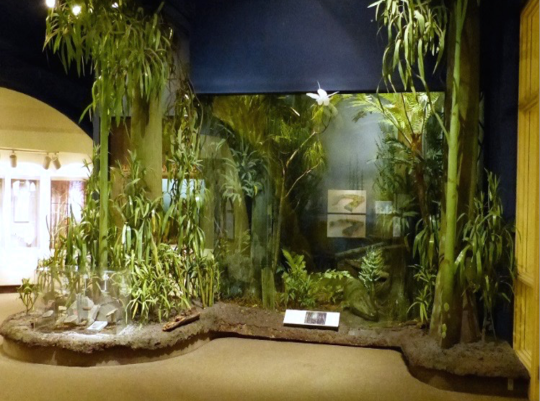
Figure 3.
In the 1940s, the 300-million-year-old Pennsylvanian age coal forest diorama was installed in a corner space of what is now part of the Benedum Hall of Geology (Fig. 3). Because coal converted to coke is a vital ingredient in steel production, this three-dimensional depiction of the conditions under which Pittsburgh’s economically important coal deposits formed was (and remains) an important public asset.
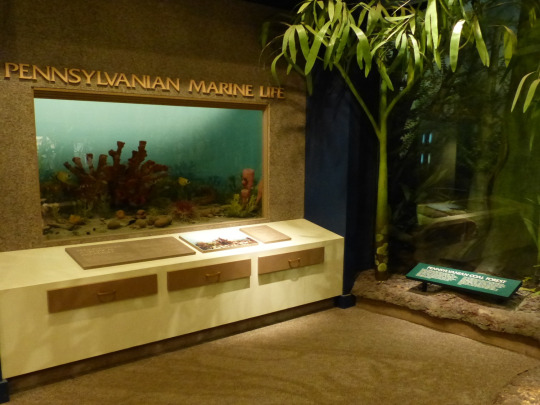
Figure 4.
In 1965, as part of an overall plan to bring more of the natural history museum’s fossil collection to the public, Paleozoic Hall opened with funding from the Richard King Mellon Foundation¹⁰. This exhibition featured nine dioramas that recreate the ancient environments through 290 million years of Earth history. Sadly, only one of the nine units remains on display, the diorama depicting the Pennsylvanian age marine seaway (Fig. 4), in the Benedum Hall of Geology.
Since the Benedum Hall of Geology opened to the public in 1988 the exhibition has featured an economic geology component with displays explaining differences between coal ranks Lignite coal to anthracite coal, and a variety of Pennsylvania’s crude oils and lubricants processed from the historic well Edwin Drake drilled in Titusville in 1859 (Fig. 1 )¹¹.

Figure 5.
Today, the Hall’s “strata wall,” a towering depiction of some of the rock layers found thousands of feet below western Pennsylvania, is in my opinion, an under-utilized display in terms of conveying information about fossil fuels. Although the wall is not currently documented with any geologic information, minor changes might allow visitors to use the lens of rock strata to better understand historical events such as the Drake Well, and economically important geologic reservoirs such as the Marcellus Shale (the second largest gas deposit in the United States), the natural gas storage reservoir of the Oriskany Sandstone, and the gas and liquid condensate (ethane) extracted from the Utica Formation (Ordovician Age) for making plastic products at the Shell Cracker Plant in Beaver County, PA (Fig. 5).
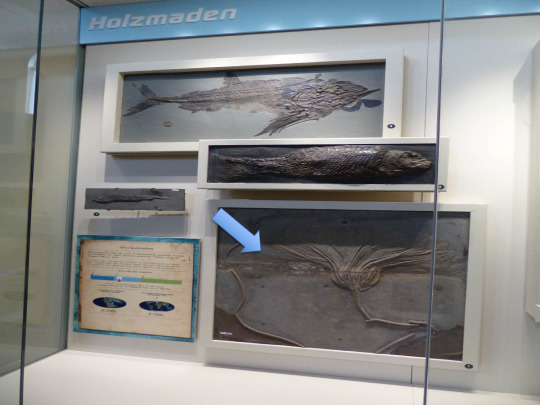
Figure 6.
Elsewhere in the museum, visitors can learn more about the topic of fossil fuels at several other locations. At the Holzmaden fossil exhibit in Dinosaurs in Their Time, there is a large fossil crinoid preserved in a dark gray limestone of Jurassic age, that represents a reservoir of crude oil in Germany (Fig. 6). At the mini diorama of the La Brea tar pits, oil seeps from natural fractures from an approximately six-million-year-old rock of Miocene age, to the unconsolidated surface sediment in what is now part of the City of Los Angeles (Fig. 7).
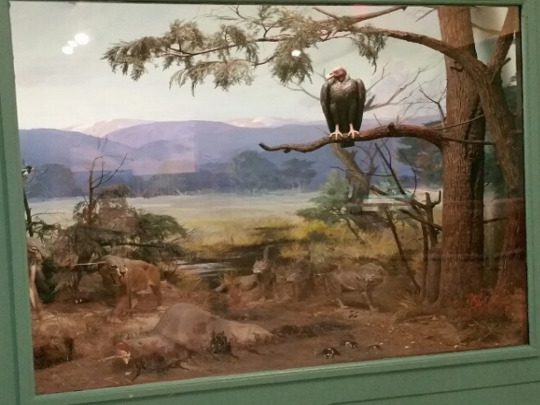
Figure 7.
Looking for Fossil Fuel Evidence in Art
In 2018, I reviewed 58 landscape paintings and the John White Alexander wall murals on the first and second floors of the Grand Staircase within Carnegie Museum of Art (CMOA) galleries to look for artistic documentation of what I interpreted to be causes for climate change based on the science. I found many examples based on the use of coal as a fossil fuel for power and coking in steel mills and the natural formation of bio-methane as portrayed in ecosystem landscapes of the industrial age of the middle 19th and early 20th century¹².
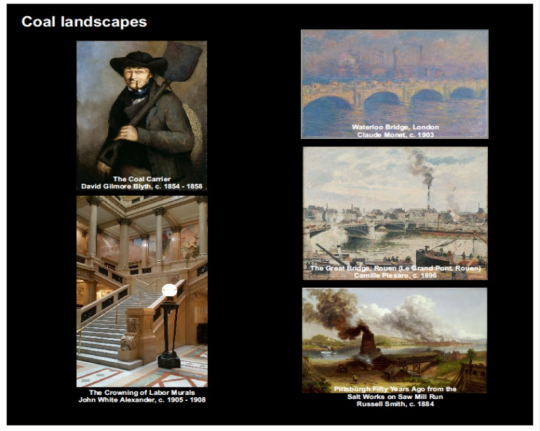
Figure 8.

Figure 9.
Searching for the CMOA landscapes paintings takes a little patience, but the visitor is rewarded by taking a new look at some of the art museum’s classic paintings (Fig. 8 and 9).
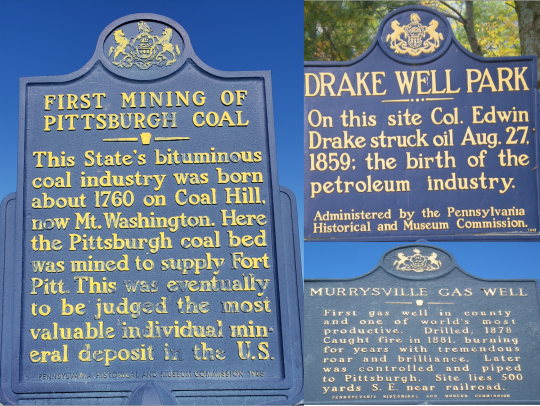
Figure 10.
Within day trip visiting distance of Carnegie Museums are historic plaques highlighting the discovery of coal on Mount Washington, natural gas in Murrysville, and oil in Titusville, Pennsylvania. (Fig. 10). At all three stops you’ll have a better understanding of the significance if you begin your investigation of fossil fuels at Carnegie Museums.
Albert D. Kollar is the Collection Manager for the Section of Invertebrate Paleontology. Suzanne Mills is the Collection Assistant and Joann Wilson is a volunteer Section of Invertebrate Paleontology.
References
1. Kollar, A.D. 2020. CMP Travel Program and Section of Invertebrate Paleontology promotes the 125th Anniversary of the Carnegie Library of Pittsburgh with an outdoor walking tour. https://carnegiemnh.org/125th-anniversary-carnegie-library-of-pittsburgh-outdoor-walking-tour/
2. Personal communications Anthony J. Young, Vice President (FP&O) Carnegie Museums of Pittsburgh.
3. Brezinski, D. K. and C K. Brezinski. 2014. Geology of Pennsylvania’s Coal. PAlS Publication Number 18.
4. Geology of the Marcellus Shale. 2011. Brezinski, D.K., D. A. Billman, J.A. Harper, and A.D. Kollar. PAlS Publication 11.
5. https://www.bloomberg.com/news/articles/2021-05-03/coal-consumption-in-the-u-s-declines-as-natural-gas-solar-wind-energy-rise
6. United States Energy Agency (EIA) 2019.
7. Bill Gates. 2021. How to Avoid A Climate Disaster.
8. Kollar et al. 2020. Carnegie Institute Extension Connemara Marble: Cross-Atlantic Connections Between Western Ireland and Gilded Age Architecture in Pittsburgh, Pennsylvania. ACM, 86, 207-253.
9. Dawson, M. R. 1988. Benedum Hall of Geology. Carnegie Magazine, 12-18.
10. Eller, E. R. 1965. Paleozoic Hall. Carnegie Magazine, 255-338.
11. Harper and Dawson 1992. Benedum Hall-A Celebration of Geology. Pennsylvania Geology, 23, 12-15.
12. Kollar et al. 2018. Geology of the Landscape Paintings at the Carnegie Museum of Art, a Reflection of the “Anthropocene” 1860-2017. Geological Society of America, Abstracts with Programs, v. 49, 243.
33 notes
·
View notes
Photo
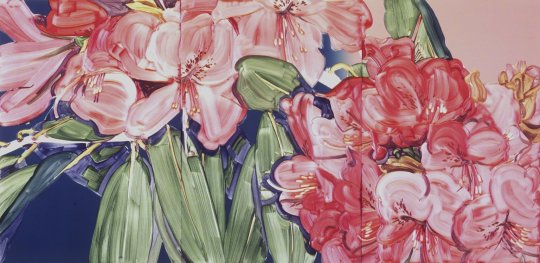
Springtime in Brooklyn by Nancy Rosoff, Andrew W. Mellon Senior Curator, Arts of the Americas
As I look out my window at the falling rain, I know that these April showers will soon be followed by May’s flowers. The vibrant colors of budding trees and blossoming flowers give us hope that we will overcome the current crisis, and the world will be rejuvenated, stronger, and more unified. The following works from the Brooklyn Museum’s diverse collection celebrate the arrival of Spring and our hope for a healthy and more peaceful world.
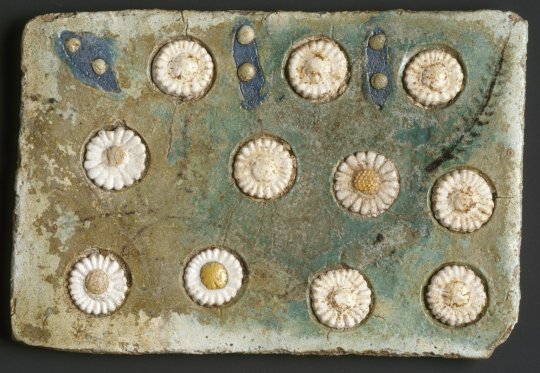
Brightly colored plants and flowers made of faience once decorated the walls of the Great Palace of king Akhenaten at Amarna. Sun light and the disk of the sun itself became the focus of religious worship in the Amarna period (1353-13336 B.C.E.). The floral motifs of these tiles were meant to evoke rebirth of life brought about by the sun. See the artwork in our open collection.
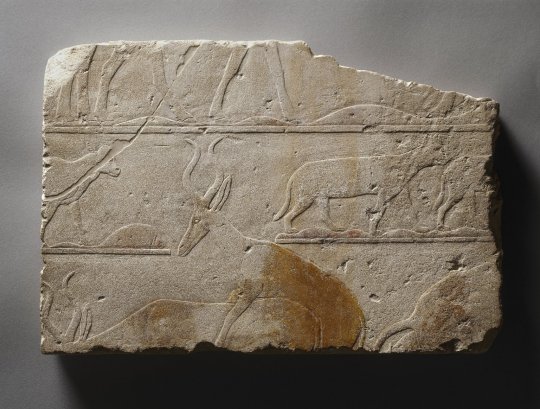
While the Nile was revered as a life-giving place, the desert was also teeming with nature. Here one can see animals breeding in their desert environs. To the right, a feline is showing interest in another feline. At the lower left, a male antelope, mounting his mate, rears his head into the row above. At the lower right, the hindquarters of an antelope giving birth and the emerging head of her calf are partly preserved. The bovine calf at center left completes this depiction of the cycle of life. See the artwork in our open collection.
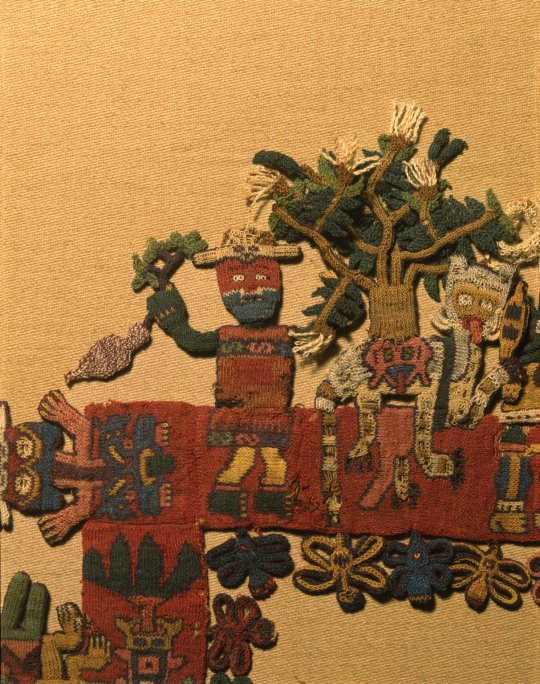
This detail from a Nasca mantle not only illustrates some of the plants and animals native to Peru’s South Coast, but it also conveys how the society’s spiritual beliefs are connected to agricultural seasons. The blossoming huarango tree seen here represents life and is shown growing out of a human trophy head on the back of a pampas cat. The trophy head symbolizes death but it is also a germinating seed from which life sprouts in a never-ending cycle of life, death, and rebirth. See the artwork in our open collection.
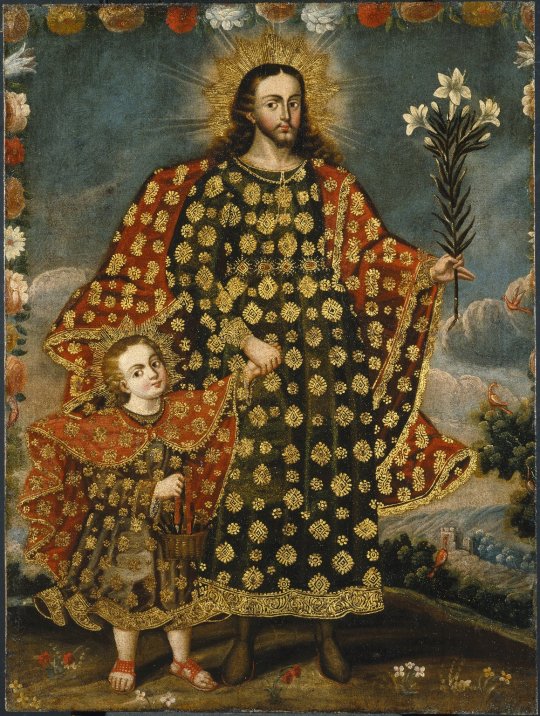
This late-seventeenth-century painting from viceregal Peru shows Saint Joseph standing hand-in-hand with the Christ Child in a field of blooming flora and enclosed within a border of bright carnations and lilies. Saint Joseph’s popularity flourished at this moment in the Spanish Americas as he embodied ideals of fatherhood, marriage, divinity, and masculinity. Here, he holds a stem of white lilies, which symbolize his holiness and purity. See the artwork in our open collection.
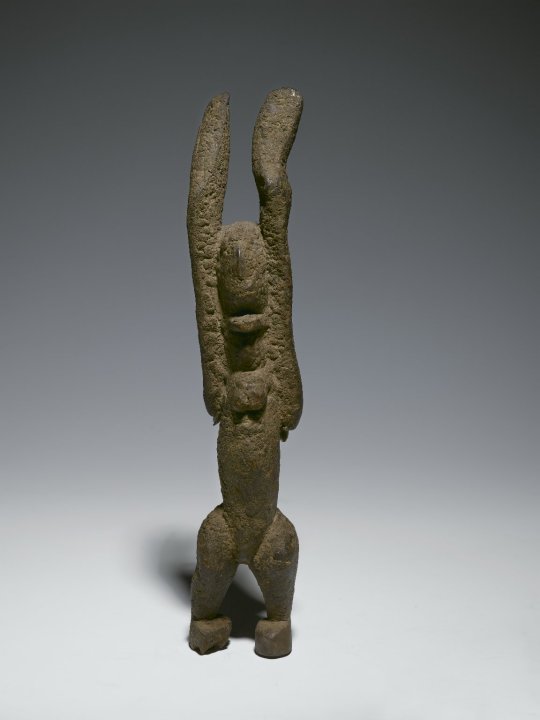
This sculpture would have served as a means for people to contact spiritual intermediaries for aid. Its raised arms are said to refer to prayers for rain, crucial to survive and thrive in arid the Mopti Region of Mali. See the artwork in our open collection.
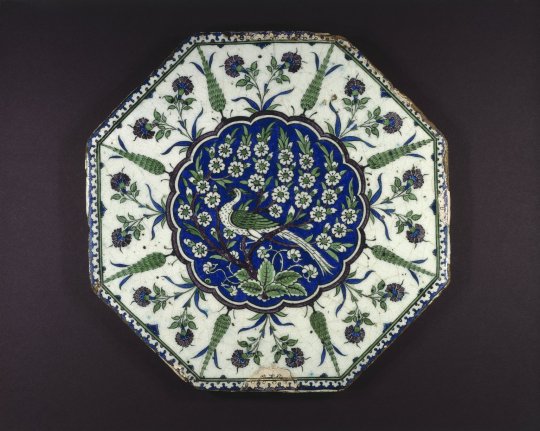
The use of naturalistic floral motifs, such as carnations, tulips, and hyacinths, was a trademark of the design workshop of the Ottoman court in Istanbul in the mid-sixteenth century. This design principle was adopted in central and distant areas of the empire and applied to different media, such as manuscript illuminations made in Istanbul, textiles made in Bursa, and tiles made in Iznik and Damascus. This octagonal tile from Syria brings the beauty of spring indoors permanently. See the artwork in our open collection.

Vibrant greens and blues bring a spring woodland scene inside the Museum, creating an eternal verdant landscape. The effects of changing sunlight or a passing cloud can animate the glass used to depict the stream, tree trunks and leaves. Originally installed in the Universalist Church of Our Father at Classon and Atlantic Avenues in Brooklyn, the windows were purchased by the All Souls Universalist Church on Ocean Avenue and installed in 1945, before coming to the Brooklyn Museum a few years ago. Tiffany Studio was extremely skilled at creating panoramas that open onto lush, brilliantly colored vistas. See the artwork in our open collection.
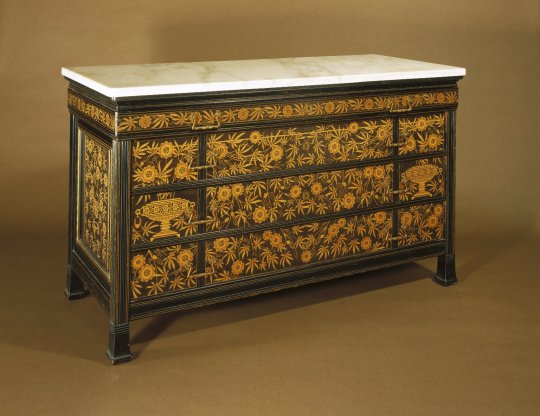
This elaborately decorated cabinet brought ever-blooming flowers into the owner’s bedroom. Inspired by Japanese precedents, New York’s most important late-19th-century furniture manufacturing firm Herter Brothers employed different colored woods to create the densely packed, abstracted flowers and leaves on this luxurious, yet functional chest-of-drawers. See the artwork in our open collection.

In the Japanese tradition, cherry blossom season is a time for celebration: the world wakes up after a long winter and people head outside to gather under the pink-and-white canopies created by trees that seemed barren only a week or two earlier. This year the picnics were cancelled, but in nature the show goes on whether there’s an audience or not. See the artwork in our open collection.
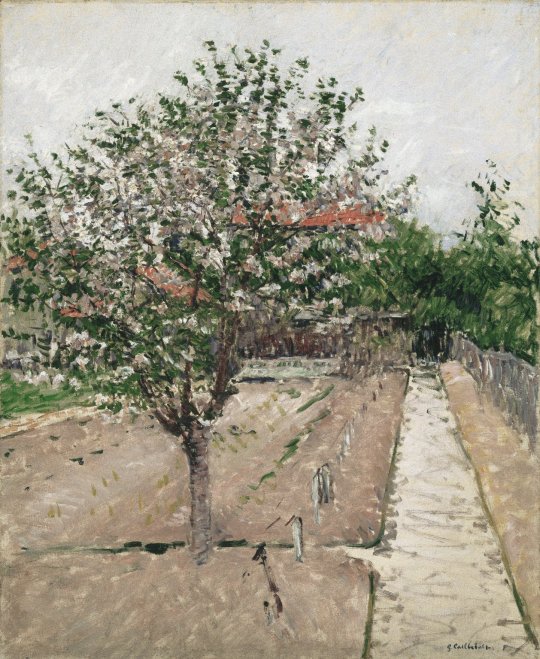
In this painting, Gustave Caillebotte offers a glimpse of his private garden in Petit Gennevilliers, a small village on the Seine opposite Argenteuil. The apple blossoms are rendered in thick touches of paint, which contrast with the sketchy treatment of the path that leads toward the denser foliage beyond the tree. See the artwork in our open collection.

Nothing celebrates Spring more than this dazzling child’s cap with its delicate beadwork on vibrant rose-colored velvet. It was lovingly made by the mother or female relative of a little girl who would have worn it with pride during special occasions. See the artwork in our open collection.
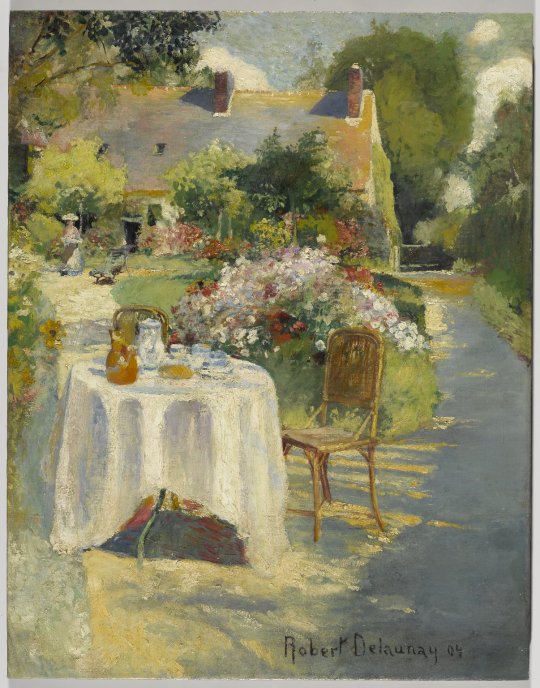
A table set with bread and coffee in a blooming garden along a sun-dappled path conjures the pleasures of the warmer months to come. Robert Delaunay would become known later in his career for more abstract work, but in this early painting the 19 year old artist was still working under the influence of Impressionism. See the artwork in our open collection.
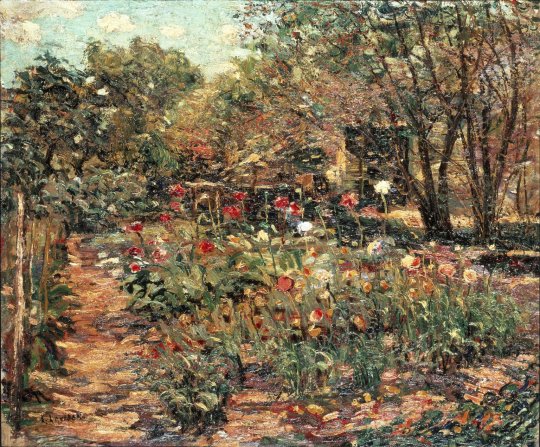
Redolent with the sweet scent of peonies, American Impressionist Ernest Lawson paints his flowerbeds in a dazzling display of jewel like tones in the Cos Cob art-colony located along the Connecticut shore. See the artwork in our open collection.
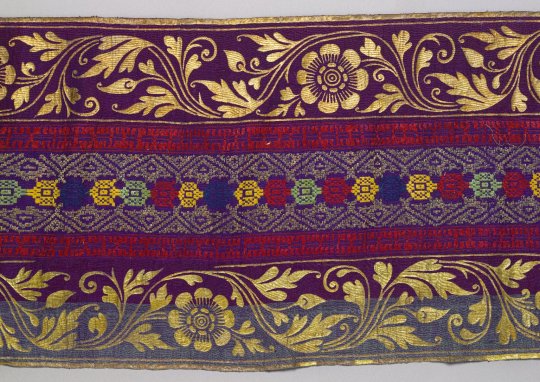
This Balinese cover features bright brocade rosettes in purple, blue, red, yellow, and green. The gilded gold overpaint features patra cina designs borrowed from Chinese floral patterns. Together, they create a glittering textile that is awash with color and floral motifs. See the artwork in our open collection.

One of the Brooklyn Museum’s most important Japanese paintings is a folding screen showing a group of urbanites walking together, followed by a musician and a servant with a big box. The only clue that they are heading to a cherry-blossom-viewing picnic comes from a woman who extends a branch of flowering cherry back toward a group of men. Attached to the branch is a long strip of paper of the type used traditionally in Japan for writing poems. What does the poem strip say? We don’t know, but it seems fair to guess that it serves as an invitation to romance. The screen reminds us that the spring tradition of partying beneath the cherry trees wasn’t solely about communing with nature. See the artwork in our open collection.
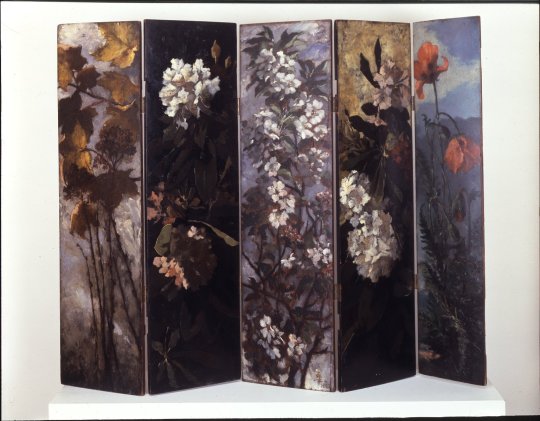
Inspired by Japanese folding screens or byōbu, Elizabeth Boott Duveneck’s five panels bring the natural world into the interior of the house depicting all four seasons from Autumn Foliage to Apple blossoms throughout the year. See the artwork in our open collection.
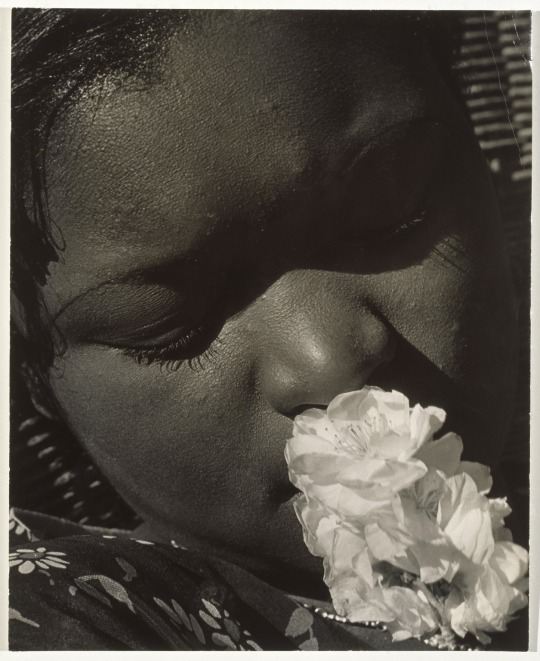
Beginning in the early 1930s, Consuelo Kanaga became one of few white photographers to make artistic portraits of Black Americans. This closely cropped and sharply focused image of a girl’s face with a flower was likely included in Group f.64’s inaugural exhibition in 1932, which announced a new realist direction in photography. Considered radical in its time, Frances with a Flower explores powerful ideas about beauty, gender, and race. See the artwork in our open collection.
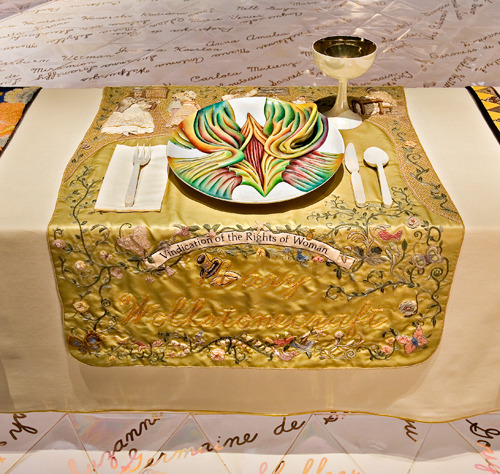
Mary Wollstonecraft was a renowned women’s rights activist who authored "A Vindication of the Rights of Woman," (1792), a classic of rationalist feminism that is considered the earliest and most important treatise, advocating for equality and education for women. Akin to the nature of Spring, Wollstonecraft's life symbolized the fruition of a legacy—from which infinite linages of women continue to reap the fruits of her labor. See the artwork in our open collection.
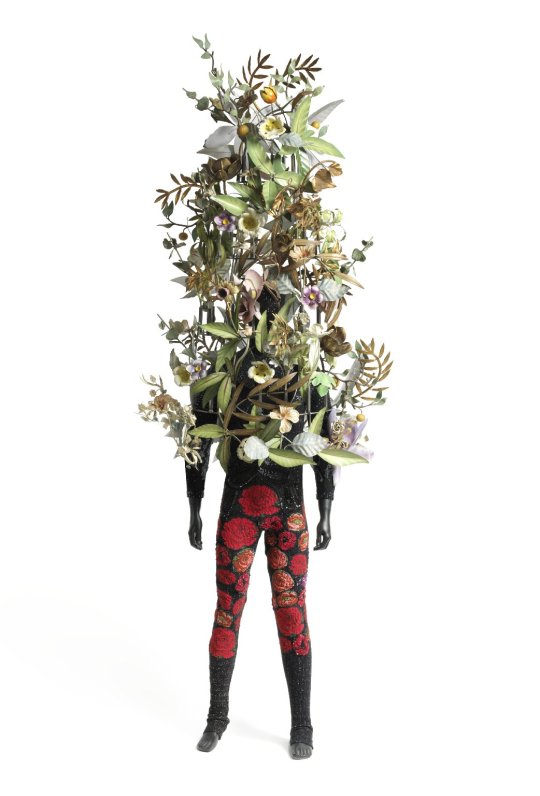
With rose-patterned leggings and an elaborate floral armature/headdress, Nick Cave’s Soundsuit transforms the human body into a lush garden. Since the early 1990s, Cave has been fabricating inventive sculptures out of scavenged materials, which he often overlays with beadwork, stitching, and other embellishments. One of the first, crafted from twigs, was made to be worn and created a rustling sound, which led to the eventual name of such works: Soundsuits. Cave’s costumes draw from a variety of sources, including both African and Caribbean traditions of masquerade. See the artwork in our open collection.
Posted by Nancy Rosoff with contributions from the Curators and Curatorial Assistants of African, American, Ancient Egyptian, Arts of the Americas, Asian, Contemporary, Elizabeth A. Sackler Center for Feminist Art, and Islamic Art
Photos: Gary Alan Bukovnik (American, born 1947). Rhododendrum, 1980. Lithograph on paper. Brooklyn Museum, Gift of the artist, 81.15.2. © Gary Alan Bukovnik(Photo: Brooklyn Museum); Tile with Floral Inlays, ca. 1352-1336 B.C.E. Faience. Brooklyn Museum, Gift of the Egypt Exploration Society, 35.2001. Creative Commons-BY (Photo: Brooklyn Museum); Relief with Desert Scene, ca. 2472-2455 B.C.E. Limestone, pigment. Brooklyn Museum, Charles Edwin Wilbour Fund, 64.147. Creative Commons-BY (Photo: Brooklyn Museum); Nazca. Mantle ("The Paracas Textile"), 100-300 C.E. Cotton, camelid fiber. Brooklyn Museum, John Thomas Underwood Memorial Fund, 38.12; Cuzco School. Saint Joseph and the Christ Child, late 17th-18th century. Oil on canvas. Brooklyn Museum, Museum Expedition 1941, Frank L. Babbott Fund, 41.1275.191 (Photo: Brooklyn Museum); Dogon. Nommo Figure with Raised Arms, 11th-15th century (possibly). Wood, organic sacrificial material. Brooklyn Museum, The Adolph and Esther D. Gottlieb Collection, 1989.51.39. Creative Commons-BY (Photo: Brooklyn Museum); Octagonal Tile Depicting Peacock in Prunus Tree, 16th century. Ceramic; fritware, painted in black, cobalt blue, green, and manganese purple under a transparent glaze. Brooklyn Museum, Gift of Jack A. Josephson, 1990.21. Creative Commons-BY (Photo: Brooklyn Museum); Tiffany Studios (1902-1932). Dawn in the Woods in Springtime, 1905. Stained glass window. Brooklyn Museum, Gift of All Souls Bethlehem Church, 2014.17.1. Creative Commons-BY; Herter Brothers (American, 1865-1905). Chest-of-Drawers, ca. 1880. Ebonized cherry, other woods, modern marble top, brass. Brooklyn Museum, Modernism Benefit Fund, 1989.69. Creative Commons-BY (Photo: Brooklyn Museum); Utagawa Hiroshige (Ando) (Japanese, 1797-1858). Suijin Shrine and Massaki on the Sumida River (Sumidagawa Suijin no Mori Massaki), No. 35 from One Hundred Famous Views of Edo, 8th month of 1856. Woodblock print. Brooklyn Museum, Gift of Anna Ferris, 30.1478.35 (Photo: Brooklyn Museum); Gustave Caillebotte (French, 1848-1894). Apple Tree in Bloom (Pommier en fleurs), ca. 1885. Oil on canvas. Brooklyn Museum, Bequest of William K. Jacobs, Jr., 1992.107.2 (Photo: Brooklyn Museum); Woodlands. Child's Cap, ca. 1890s. Velvet, cloth, beads. Brooklyn Museum, Gift of the Edward J. Guarino Collection in memory of Josephine M. Guarino, 2016.11.2. Creative Commons-BY; Robert Delaunay (French, 1885-1941). In the Garden (Dans le jardin), 1904. Oil on canvas. Brooklyn Museum, Gift of Iris and B. Gerald Cantor, 86.28 (Photo: Brooklyn Museum); Ernest Lawson (American, 1873-1939). Garden Landscape, ca. 1915. Oil on canvas. Brooklyn Museum, Bequest of Laura L. Barnes, 67.24.10 (Photo: Brooklyn Museum); Cover, 19th or early 20th century. Silk, pigment. Brooklyn Museum, Dick S. Ramsay Fund, 45.183.110. Creative Commons-BY; Cherry Blossom Viewing Picnic, ca. 1624-1644. Ink, color and gold leaf on paper. Brooklyn Museum, Gift of Frederic B. Pratt, 39.87. Creative Commons-BY (Photo: Brooklyn Museum); Elizabeth Boott Duveneck (American, 1846-1888). Apple Blossoms, 1882. Oil on wood panel. Brooklyn Museum, Gift of Joan Harmen Brown, Mr. and Mrs. William Slocum Davenport, Mrs. Lewis Francis, Samuel E. Haslett, William H. Herriman, Joseph Jefferson IV, Clifford L. Middleton, the New York City Police Department, Mrs. Charles D. Ruwe, Charles A. Schieren, the University Club, Mrs. Henry Wolf, Austin M. Wolf, and Hamilton A. Wolf, by exchange, Frank Sherman Benson Fund, Museum Collection Fund, Dick S. Ramsay Fund, Carll H. de Silver Fund, John B. Woodward Memorial Fund, and Designated Purchase Fund , 2005.54.3 (Photo: Brooklyn Museum); Consuelo Kanaga (American, 1894-1978). Frances with a Flower, early 1930s. Gelatin silver photograph. Brooklyn Museum, Gift of Wallace B. Putnam from the Estate of Consuelo Kanaga, 82.65.10 (Photo: Brooklyn Museum); Judy Chicago (American, b. 1939). The Dinner Party (Mary Wollstonecraft place setting), 1974–79. Mixed media: ceramic, porcelain, textile. Brooklyn Museum, Gift of the Elizabeth A. Sackler Foundation, 2002.10. © Judy Chicago. Photograph by Jook Leung Photography; Nick Cave (American, born 1959). Soundsuit, 2008. Mixed media. Brooklyn Museum, Mary Smith Dorward Fund, 2009.44a-b. © Nick Cave (Photo: Image courtesy of Robilant Voena)
#virtualtour#springtime#spring#brooklyn museum#museums#brooklyn#virtual tour#art#art museum#bkmtours#virtual tours
570 notes
·
View notes
Text
Happy Preservation Week! (Part 1 :)
Happy Preservation Week, everyone!
I’m Cat Stephens, an Andrew W. Mellon Fellow studying Library & Archive Conservation at NYU’s Institute of Fine Arts. At the IFA, I’m earning an MA in the History of Art and Archaeology, and an MS in the Conservation of Historic and Artistic Works, specifically in the conservation of books, paper objects, and photographs.
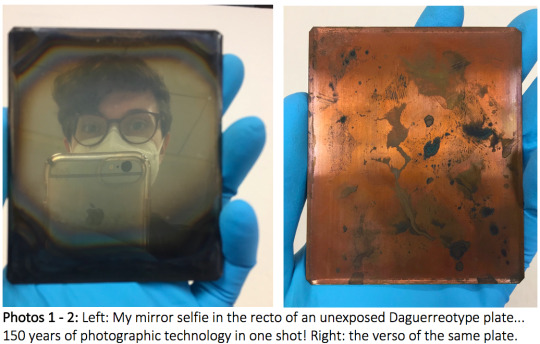
Students in my graduate program have the option to spend their year-long graduate internships almost anywhere in the world, but I chose to stick around and intern at the NYU Libraries’ Barbara Goldsmith Preservation & Conservation Department... In addition to being awesome at their jobs, the conservators here are excellent teachers, and I’ve always been impressed by the range and volume of treatments that they perform every year! Additionally, NYU has done an impressive job of reducing the spread of Covid-19 on campus, and I feel very lucky that my internship was not severely impacted by the University’s precautionary measures. Since September 2020, the library’s preservation staff and I have had the option to work in the library for 2-4 days every week, and we catch up on paperwork during our teleworking days.
Over the last seven months I’ve worked on many treatments that have helped me understand the finer points of library preservation, and I’ll describe four of my favorite preservation/conservation treatments for you over the next four days. These treatments include a 19th century publisher’s binding, a 16th century book bound in recycled parchment, a wooden box full of unexposed Daguerreotype plates, and ... a skateboard??
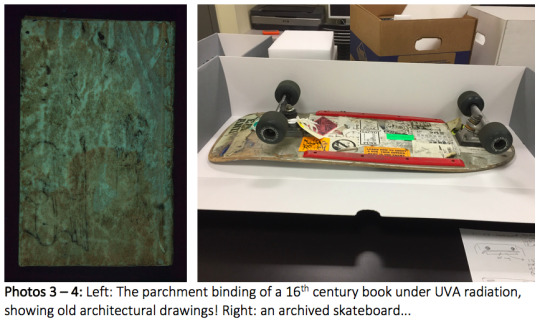
But first, unless you’re a library or museum professional, you may be wondering what Preservation Week is, and how does “preservation” differ from “conservation?” For cultural heritage institutions, Preservation Week is a yearly opportunity to draw public attention to the importance of preserving cultural heritage materials of all kinds. These materials may include modern books, medieval manuscripts, audio/visual materials like VHS tapes and home movies, photographs, scrapbooks, textiles, digital data, paper documents, and metal, wood or glass objects, just to name a few. Many of these materials are held in libraries and museums for public enjoyment, but perhaps many more are sitting in our basements and attics! If you have special things at home that you want to preserve, there are many online resources available to you, and I’ve provided links to some of them at the end of this post.
For conservators and other preservation professionals, Preservation Week is a good time to consider the enormous range of objects that we’re tasked with caring for, and to think about new ways to preserve and conserve them for the next generations. In libraries and museums, “preservation” and “conservation” refer to slightly different activities, but they both contribute to the wellbeing of cultural heritage objects. “Conservation” refers to any physical interventions performed on an object, such as cleaning, making repairs, or compensating for parts that have been lost. A conservation treatment can reduce the stains in a flood-damaged drawing, or it can transform a pile of ceramic sherds back into an ancient vase. “Preservation” usually encompasses the activities performed around an object which will minimize the object’s chemical and physical deterioration over time. Preservation activities include the making of enclosures to protect objects from physical harm, dust, or light damage, the management of pests, and the careful control of temperature and humidity in storage facilities. Preservation and conservation are two sides of the same coin, and many argue that “preservation” is the broader term which includes conservation activities. This point of view is often held in libraries, where the objects (usually books) are not just static relics of the past, they are vehicles of information; to access this information, books must be handled, and they must be able perform a kinetic function. For this reason, any conservation treatment that restores functionality to a broken book can also be considered “preservation.” Of course, many old or rare books have been digitized and made available online, but even so, scholars often want to verify and augment their online research by perusing the original book… there’s no digital substitute for the real thing :)
Thanks so much for reading, and stay tuned for tomorrow’s installment of our Preservation Week 2021 blog series, where I’ll discuss the conservation of a novel published in 1891 (photos below!)
-Cat Stephens
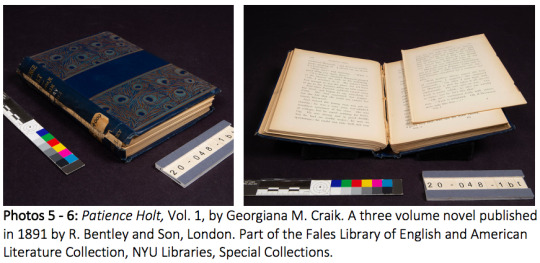
Some At-Home* Preservation Resources:
American Institute for Conservation (AIC): “Caring for Your Treasures”
American Library Association: “Saving Your Stuff”
FEMA (Federal Emergency Management Agency): “Salvaging Water-Damaged Family Valuables and Heirlooms” ... (Fact Sheets are available in English, Chinese, Vietnamese, Haitian Creole, Portuguese, and Spanish):
Minnesota Historical Society: Preserving “Clothing and Textiles”
National Archives: “How to Preserve Family Archives (Papers and Photographs)”
*But sometimes a problem is so complex that it requires a conservator… AIC’s “Find a Conservator” tool can help! https://www.culturalheritage.org/about-conservation/find-a-conservator
#PreservationWeek#Preservation#Conservation#Libraries#SpecialCollections#TodayInTheLab#NYU#NYULibraries#AmericanLibraryAssociation#ALA#NYUIFA
21 notes
·
View notes
Text
3D printing the human heart
A team of researchers from Carnegie Mellon University has published a paper in Science that details a new technique allowing anyone to 3D bioprint tissue scaffolds out of collagen, the major structural protein in the human body. This first-of-its-kind method brings the field of tissue engineering one step closer to being able to 3D print a full-sized, adult human heart.

The technique, known as Freeform Reversible Embedding of Suspended Hydrogels (FRESH), has allowed the researchers to overcome many challenges associated with existing 3D bioprinting methods, and to achieve unprecedented resolution and fidelity using soft and living materials.
Each of the organs in the human body, such as the heart, is built from specialized cells that are held together by a biological scaffold called the extracellular matrix (ECM). This network of ECM proteins provides the structure and biochemical signals that cells need to carry out their normal function. However, until now it has not been possible to rebuild this complex ECM architecture using traditional biofabrication methods.
"What we've shown is that we can print pieces of the heart out of cells and collagen into parts that truly function, like a heart valve or a small beating ventricle," says Adam Feinberg, a professor of biomedical engineering (BME) and materials science & engineering at Carnegie Mellon, whose lab performed this work. "By using MRI data of a human heart, we were able to accurately reproduce patient-specific anatomical structure and 3D bioprint collagen and human heart cells."
Over 4000 patients in the United States are waiting for a heart transplant, while millions of others worldwide need hearts but are ineligible for the waitlist. The need for replacement organs is immense, and new approaches are needed to engineer artificial organs that are capable of repairing, supplementing, or replacing long-term organ function. Feinberg, who is a member of Carnegie Mellon's Bioengineered Organs Initiative, is working to solve these challenges with a new generation of bioengineered organs that more closely replicate natural organ structures.
"Collagen is an extremely desirable biomaterial to 3D print with because it makes up literally every single tissue in your body," explains Andrew Hudson, a BME Ph.D. student in Feinberg's lab and co-first author on the paper. "What makes it so hard to 3D print, however, is that it starts out as a fluid -- so if you try to print this in air it just forms a puddle on your build platform. So we've developed a technique that prevents it from deforming."
The FRESH 3D bioprinting method developed in Feinberg's lab allows collagen to be deposited layer-by-layer within a support bath of gel, giving the collagen a chance to solidify in place before it is removed from the support bath. With FRESH, the support gel can be easily melted away by heating the gel from room temperature to body temperature after the print is complete. This way, the researchers can remove the support gel without damaging the printed structure made of collagen or cells.
youtube
This method is truly exciting for the field of 3D bioprinting because it allows collagen scaffolds to be printed at the large scale of human organs. And it is not limited to collagen, as a wide range of other soft gels including fibrin, alginate, and hyaluronic acid can be 3D bioprinted using the FRESH technique, providing a robust and adaptable tissue engineering platform. Importantly, the researchers also developed open-source designs so that nearly anyone, from medical labs to high school science classes, can build and have access to low-cost, high-performance 3D bioprinters.
Looking forward, FRESH has applications in many aspects of regenerative medicine, from wound repair to organ bioengineering, but it is just one piece of a growing biofabrication field. "Really what we're talking about is the convergence of technologies," says Feinberg. "Not just what my lab does in bioprinting, but also from other labs and small companies in the areas of stem cell science, machine learning, and computer simulation, as well as new 3D bioprinting hardware and software."
"It is important to understand that there are many years of research yet to be done," adds Feinberg, "but there should still be excitement that we're making real progress towards engineering functional human tissues and organs, and this paper is one step along that path."
Other collaborators on the paper include co-first author Andrew Lee, a BME Ph.D. student in Feinberg's lab; BME postdoctoral researcher Dan Shiwarski; BME Ph.D. students Joshua Tashman, TJ Hinton, Sai Yerneni, and Jacqueline Bliley; and BME Research Professor Phil Campbell.
141 notes
·
View notes
Photo

On November 25th 1835 the steel magnate and philanthropist, Andrew Carnegie, was born in Dunfermline.
Nicknamed, "Andra" he spent much of his early years with his uncle George Lauder who often took his son, George Jr., and Andra on long walks to tell them stories of Scottish ancestry, recite lines from Robert Burns, and also, according to Andrew, to tell some pretty scary ghost stories.
In 1848, Andrew immigrated to Allegheny, Pennsylvania in the United States. He was thirteen years old. Since his family needed the money, he immediately went to work in a cotton factory as a bobbin boy. He made $1.20 for working a 70 hour week on his first job. Andrew wasn't able to attend school, but he was an intelligent and hard working boy. During his free time he read books loaned to him from one of the local citizen's private library. Andrew never forgot how important these books were to his education and would later donate significant funds to the building of public libraries. Andrew always worked hard and did a good job. He soon got a job as a telegraph messenger. This was a much better and more enjoyable job. Andrew got to run all around town delivering messages. He also studied Morse Code and practiced with the telegraph equipment whenever he got the chance. In 1851, he was promoted to telegraph operator.
In 1853, Carnegie went to work for the railroads. He worked his way up and eventually became superintendent. It was while working for the railroads that Carnegie learned about business and investing, this experience would pay off down the road.
As Carnegie made more money, he wanted to invest his money rather than spend it. He invested in various businesses like iron, bridges, and oil. Many of his investments were successful and he also made a lot of business connections with important and powerful men.
In 1865, Carnegie established his first company called the Keystone Bridge Company. He began to put most of his efforts into ironworks. Using his connections with the railroad companies, he was able to build bridges and sell railroad ties made by his company. He expanded his business over the next several years, building factories throughout the region.
Carnegie decided to invest in steel. He knew that steel was stronger than iron and would last longer. Steel would make more durable bridges, railroads, buildings, and ships. He also learned of a new steel making process called the Bessemer process that enabled steel to be made quicker and cheaper than before. He formed the Carnegie Steel Company. He built a number of large steel factories and soon had a large percentage of the world steel market. In 1901, Carnegie formed U.S. Steel with the banker J. P. Morgan. This became the largest corporation in the world. Carnegie had gone from a poor Scottish immigrant to one of the richest men in the world.
Carnegie believed in working hard and taking calculated risks. He also invested in vertical markets. This means that he didn't just buy the ingredients for steel and then make it in his factories. He also owned other aspects of the steel industry including coal mines to fuel the steel furnaces, trains and ships to transport his steel, and iron ore operations.
Carnegie felt that being rich was just the first part of his life. Now that he was rich, he decided that he should spend the rest of his life giving away his money to needy causes. One of his favourite causes was libraries. His funding contributed to over 1,600 libraries being built around the United States and the world. He also gave money to help with education and funded the building of Carnegie Mellon University in Pittsburgh. Other projects included purchasing thousands of church organs, building Carnegie Hall in New York City, and forming the Carnegie Foundation for the Advancement of Teaching.
Carnegie died of pneumonia on August 11, 1919 in Lenox, Massachusetts. He left the majority of what remained of his wealth to charity.
A few more facts about oor Andra,....
Carnegie was in charge of the Union army's railroads and telegraph lines.He once said that "You cannot push any one up a ladder unless he be willing to climb a little himself."
It is estimated that, accounting for inflation, Carnegie was the second richest person in the history of the world. The richest was John D. Rockefeller.
He felt so strongly about giving his money away that he wrote in his book The Gospel of Wealth that "The man who dies thus rich, dies disgraced.
He once offered to give the Philippines $20 million in order for the country to buy its independence.
There's a much more detailed account of his life here https://www.nps.gov/jofl/learn/historyculture/andrew-carnegie.htm
14 notes
·
View notes
Text
DBHI: Equilibrium, ch. 13 - “Periapsis” (pt. 1)
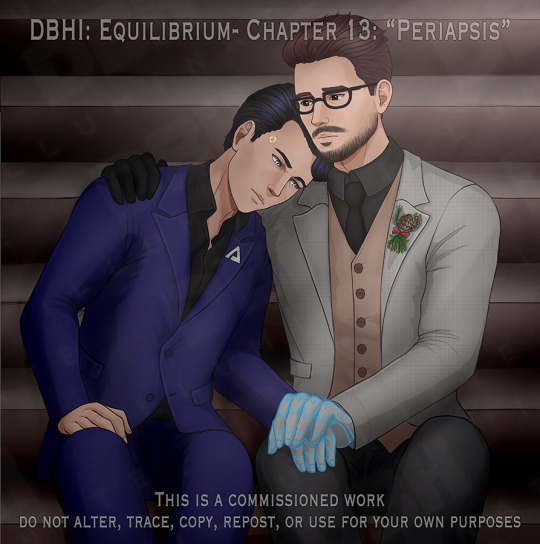
Characters: Noah / “Erwin Yvonne”, Gabriel / “Vincent Sharp”, Special Agent Gavin Reed, Director Thomas Falken Word Count: 2,842
Noah crashes an undercover FBI operation to say hello to a friend he hasn't seen or spoken to in a couple of months, but the mood is spoiled when the Zionist Inquisition shows up to deliver an ultimatum to Vincent Sharp, and issue a threat to anyone who would dare support the installation of an android suburb in Washington, DC.
***For a glossary of world-building terms relating to this series and chapter, click here.
(Chapter Art by ozaya, Co-authored by @grayorca15)
• Chapter Index • Characters • Glossary •
——
December 23rd, 2041 - 9:45 PM
From the outside, the looming auditorium locally known as The Mellon was unchanged. Whatever techno-aesthetics the Capitol had adopted in the last two decades, Washington, DC’s architecture was still mostly the same neoclassical Roman-inspired drivel the Founding Fathers probably thought the height of grandeur that any respectable city could model itself after. This particular building was very much a product of its time- a perfect encapsulation of the stiff right angles, thick brooding columns, and bleak texture-less walls, suggested nothing of what might actually be happening beyond the foyer. The red-green cutout projections of trees and reindeer and ornaments dancing across the Columbia pediment sculpted across its tented promenade and the delicate string instruments currently honoring an orchestral cover of one of a hundred classic Christmas songs was a hint though.
Noah stepped out of the Jaguar to be accosted by a shower of holographic white and blue snowflakes, mixed with the real-life equivalent wafting about that cold winter’s night. They swarmed like his very own plague of too-friendly gnats. Whatever property-wide projection program the event had been accentuated with, the programmer had evidently spent too much time re-watching Frozen as a child. He pulled his sunglasses down just far enough to peer over the lenses as a few flakes fluttered in, close enough for him to see their individual fractals, and gave an irritated huff through his nose. “Still bitter over the demise of Disney, I see.” A few seconds later, the shy valet swept around the roadster’s red taillights and apologized profusely for a near-nonexistent delay in offering to take the car to be parked. Noah felt nothing but amusement at their blathering, patted him on the shoulder and held the door open. “Quit fussing. It’s early yet, and you’ve a lot more rides to tuck in before the night’s over. Treat this one like the queen she is and there’ll be an extra fifty in it for you… Fredrick.”
The kitschy light-show and dear hapless Fred weren’t as bothersome as the front ranks of guards posted at the velvet rope-fenced entrance. The nearest man put up a hand and stopped him in his tracks at the top of the stairs. “I’m sorry, sir, but this is a charity function for contributors only. Have you made a donation?” It seemed only pre-approved guests were being permitted inside- a slight oversight on his part, but it wasn’t enough to keep him from his goal. He had a conversation to close out.
Noah popped his brows and donned a charming smile as he presented the falsified credentials, nestled in a flip-fold ID bearing the name Erwin L. Yvonne, complete with the most abhorrent manipulation of his likeness ever produced. “Not to worry, gents. I’m intimately acquainted with the curator, Mr. Sharp, and I’m here to deliver my contribution in the flesh.” Everything about the little white lie he’d spun on a whim was unnatural to him, but convincing to the two confused humans -poor, overworked and underpaid minions as they probably were- relaying questions into their headsets. After a few moments of conferring with whoever was heading security (most likely the Special Agents in charge of the sting this event was a front for), they motioned him through for a pat-down just beyond the rope. Noah didn’t bother feeling offended at them for only doing as they were instructed, but he did have a little fun making them as uncomfortable as possible as they searched his person for weapons. If his disguise, an old favorite thrown together on such short notice, held up to that much, then the rest would be a cakewalk- not that he had ever harbored a desire to actually go skipping through a fully-stocked dessert table. As fun as it sounded, he had enough messes splashed all over his real name without adding another to the list.
To his relief, the reach of the holographic snowflakes stopped at the door and vanished as he crossed the threshold of the foyer. The marble floor of the lobby had been buffed and waxed to a soft shine, and was still holding up to the foot traffic four hours after the meet’s commencement. Noah only paid enough mind to the guests still loitering about in groups no larger than six people to disinterestedly scan their faces at a glance and assign his background processes the menial task of matching names and dossiers to them. At the moment, he was far too focused on finding the one disguised face among them who was of any real importance to care about much else.
Mr. Vincent Sharp. Or should he say, Gabriel Reed.
The main hall was a wide, cavernous space, with rows of columns standing off to either side. Gold leaf sconced wall lamps provided an accentuating glow compared to the three giant chandeliers of brass and aluminum that bathed the room in ambient light. The dazzling light-show playing outdoors was only outdone by the splendor of one thirty-foot tall balsam fir erected in the center of the floor, adorned with no less than one hundred feet of multicolored string lights, dozens of strands of tinsel, swaths of garland, and a few hundred bauble ornaments. The topper, a white tinsel angel with glittery wings, faced the entrance with its hands pressed together and head bowed as if to thank all who arrived. A few outlying rings of cocktail tables surrounded the roped-off centerpiece. Those guests who weren’t conversing had taken seats to sip champagne or nibble on appetizers while they caught up on their gossip. Each cloth-covered table possessed its own small topper of a larger holographic projection of snowflakes hanging stationary in midair, which constantly shifted from one pattern to the next, spinning like a globe on a stand whenever a curious hand reached out to ‘tap’ them.
A small stage nestled in an alcove against the back of the ballroom hosted a classical band (ruled by one full-size concert piano) who looked as superfluous as the snowflakes that had greeted him outside. They wound through the last chorus of Chestnuts Roasting on an Open Fire as he descended the staircase, before starting back up with Jingle Bell Rock. Between the cello and violins, Noah’s hypersensitive ear detected at least three strings in need of tightening before he shunted that note aside to take a backseat with the rest of his anxieties. He hadn’t spent two hours biting his knuckles over ever approaching the Andrew W. Mellon Auditorium just to show up and critique its acoustic entertainment.
It wasn’t until a few curious eyes had turned his way, nodded and bid him good evening, that Noah realized how entirely inappropriate it was to be wearing sunglasses indoors, much less an event so high-class. The rest of his ensemble was tame enough- a dark navy blue suit bearing pointed lapels and a Zion sigil pin, complimented by a black dress shirt and loafers. The mild dose of glitter effect (same as could be found on the snow outside) projected into his black hair, accented with blue highlights, wasn’t as much of an affront as the pair of Ray Bans. Before anyone could make much of a fuss about it, he pulled them off and stashed the specs in his jacket’s breast pocket; in this kind of crowd, acting appropriate was of the utmost priority. Except when it wasn’t. Off to the left was a fully stocked pop-up bar- heads of the handful of people standing near it were turned away, giving off all manner of unapproachable vibes, including the only familiar silhouette in the room. Noah fought back a smirk when he spotted one particular set of ears before the facial recognition software even kicked in. As much as he would have loved to surprise him with his presence, he knew better than to sneak up on the owner of said ears. The last time he’d done so, Noah had wound up laid out over the fragments of his former coffee table, and he wasn’t eager to experience the cocktail hour equivalent of that encounter.
A half-hearted sweep of the room offered a few other suggestions of anything amiss, and that conclusion was about as dull as dishwater. Noah wasn’t really feeling making a scene with another guest (this event was far too classy for such delinquency), nor was he feeling at all confident enough to steal the mic off its stand and serenade the entire room. But that Christmas tree… it was giving off far too many signals to only be rigged with illumination accents. On his optical spectrum, a cloud of static encircled the poor displaced flora from top to bottom, a few of which were emitting from little lens-capped nodes disguised as burnt-out bulbs along the string. He drifted over casually and leaned in as if to admire his reflection in one of the gold metallic baubles, then carefully reached past the rope to twist and unplug one of the planted camera bulbs like plucking a petal off a flower. The fir gave only a whisper-quiet tink at this attack. The light strand continued to blink and cycle away, regardless of the missing piece. Noah held it up to eye level with a triumphant, yet mischievous grin. He knew exactly who was on the other side of the monitor observing the footage.
And having the most important discussion of the holiday season. On the other end of the feed, tucked away in the off-limits green rooms of the hall, Special Agent Reed was too busy engaging in one of his favorite pastimes of discussing classic action flicks with the unbaptized to notice that one of their cameras was moving. “I’m tellin’ you, man, Die Hard is THE Christmas movie, and if you don’t agree you’re just wrong .” “No way,” a second agent argued, “Bruce Willis himself denied that shit more than twenty years ago…” Reed let out a laugh that bordered on mocking, shook his head, and gestured to the man with one scolding finger lifted off his coffee cup. “John McClane would disagree-“ “Hey! Dumbasses! Stay focused!” Director Thomas Falken -who had insisted on overseeing the sting himself, in the event that something went horribly wrong - barked at the yapping men with a threatening leer that snapped Gavin’s head around and back into focus. On the feed of one of the bulb-cameras, an unrecognizable man rolled the glass node between his fingertips like a gem, and smirked as he held it up to the light. Reed’s brow furrowed in distress as he mumbled “What the fuck…?”, then swiped the walkie off the counter to relay the information. “Gabe.” “What is it, Reed?”
All done up in the swankest cocktail suit anyone would ever see him in, ‘Vincent Sharp’ turned, then leaned with his back against the bar and nursed a drink as he scanned the room through half-framed, squared-off, horn-rimmed glasses. One idle hand reached to throw back the hem of the tweed charcoal gray blazer, exposed the light brown waistcoat hugging his waist and hips, and slipped into the pocket of a pair of perfectly tailored, black slim-legged slacks. “We may have trouble, one of our spycams has been compromised.” Gabe tipped back his head and emptied the glass in his hand to smother the outward reaction of surprise, then set it down on the counter and gestured to the bartender for another. Rather than reach for any of the bottles displayed on the back counter, she went for a decanter on the shelf below the bar and refilled the glass with a burgundy brown liquid- thirium, distilled and dyed to mimic the appearance of Scotch. "Just one?” he asked in a curious tone as he searched the crowd around the tree. From his vantage point, he couldn’t clearly see anyone acting suspiciously. “Yeah, it’s the weirdest thing… little shit’s just holdin’ it up and grinnin’ like he knows we’re here…” And that he did. The harsh whisper to emanate over the commandeered camera’s mic said as much:
Good evening, Special Agent Reed. Fancy seeing you here.
From the other side of the room, Gabriel’s head turned a tic at the sound of crashing equipment and a few muttered ‘shit Shit, SHIT’s coming from the other end of the frequency he was currently tuned to. Like a bull in a china shop.
“How does he know you’re here… !?” Falken -known in his social circles as Tomahawk, for good reason- boomed from across the room as he rose from the couch and stormed over to the monitors. He shoved Reed’s chair aside, and scrutinized the face of the man making a mockery of their carefully planted monitoring equipment. Gavin’s heels scraped against the hardwood as he backpedaled and held his hands up in surrender. “I- I- I don’t… I don’t know, I didn’t tell anyone, I swear-” “Then who is THAT?” Falken punctuated with a slam of his palm against the monitor that made everyone in the room jump. “That’s… that’s, uh-...” He could explain that, but he wasn’t sure he wanted to. No matter how he looked at it, he was to blame for his presence that evening. His negligence had compromised months of careful planning.
“...Gavin?” His target rose from a table toward the front of the ballroom and directed his attention toward the bar, leering with the clear intent of starting a conversation. What impeccably bad timing for this to go down. “Reed! Talk to me!”
Gabriel’s intrusion provided him with the convenient excuse he needed to disengage for a moment. One visibly-shaking hand swiped the walkie off the desk and Gavin turned to break away from the glower of Falken’s death-glare long enough to respond to his partner in the field. The other hand ran through his hair with a nervous twitch in his fingers and he glanced over his shoulder as he cleared his throat and swallowed, then mumbled, “It’s-... it’s Noah,” under his breath just loud enough for him to hear.
Gabe’s thought processes came to a screeching halt as his personal life collided with his alias for just a moment. To hear that Noah was in Washington, DC, much less at the Zion Founders Fundraiser, was the last thing he’d expected to hear that evening. As Reed continued to drop curses in the background, Gabe turned to face the bar and flashed a polite, but forced smile at the bartender as she eyed him with nervous sweeps. He didn’t reach for the glass right away as it was set in front of him on a small black napkin. “Please, tell me I didn’t just hear what I think I did…” he muttered internally as a dozen different possibilities for how the night would turn out flashed thumb-nailed pre-constructions across his HUD. But Reed’s uncomfortable sputtering confirmed what he was hoping was just a joke.
“No, you heard me right.” One hand swiped over his face in a downward motion and scratched in frustration at the stubble he hadn’t bothered to shave in almost a week and desperately avoided Falken’s infuriated ‘what the fuck’ gestures in the background. “The bastard’s actually here, arrived in DC last night with Hannah and President-Elect Kamski. H-he stopped by the house lookin’ for you, but I told him you were undercover an’couldn’t make an appointment. I told him t’keep his nose outta our shit, but he-” Reed paused and squinted over Falken’s shoulder as Noah slipped the tiny camera into his pocket with a ‘Can you hear me alright in there?’ “Oh, son of a….” “What the hell is he doing…?”
The camera-bulb didn’t act as a walkie. And to their credit, all the personnel Noah could plainly see -now that his recognition software had sorted fact from fiction- didn’t stir, much less blow their cover. He knew without being told what this sting was about, and who it was the FBI were really here to keep tabs on. Perhaps him showing up was akin to being a ‘fly in the ointment’, but as yet he hadn’t done anything other than offend their Christmas tree. He gave the indifferent lens one more wordless glance as he rolled the bulb between his fingers. For a brief moment he considered winking at it, but decided at the last moment to pocket the device instead. Perhaps it’d come in handy elsewhere- for someone who hadn’t been properly equipped for this operation, it was the best he could do on such short notice. Failing that, he could always speak very loudly and deliberately at Gabriel’s collar mic, if he’d let him get close enough. The owner of the ear he recognized from before still hadn’t turned around. Outwardly he didn’t look very distressed. Only the new hunch in his shoulders, invisible to the human eye as it was, said it all. Far be it from him to keep ‘Vincent’ in suspense.
2 notes
·
View notes
Text
Off the Record Chapter IV
read chapter one
read on ao3
Looking up at the knock on his office door, Alec raises a brow at this floor’s administrative assistant.
“What’s up?”
Maia steps into his office and it’s then that he notices the garment bag slung over her shoulder. “Special delivery from a courtier downstairs. I was told to give this to you immediately.”
Taking the bag, she hangs it up on a hook on the back of his door. Looking over her shoulder, she adds, “Are you ready for tonight?”
Alec looks back at his computer at his half-finished email to CNN’s publicist informing him of his next assignment that will start in two days. Most of his mind’s still on that whenever he replies, “Of course. It’s a press dinner. I’ve been to a million of these things. It’s a few hours of reviewing the biggest stories of the past year while waiters in white tie serve lukewarm chicken and undercooked carrots.”
He’s rewarded with Maia cracking a smile that’s more of a grin as she dryly offers, “No need to sound so excited, Lightwood. Aren’t you up for an award?”
Leaning back in his chair, Alec nods. “Yeah,” he confirms. “There are a lot of other great journalists covering a lot of important topics too, though. Competition is stiff.” He flashes a self-deprecating grin. “Better to keep my expectations low.”
“Whatever you say, boss.” She jerks her head to the nondescript garment bag. “A Magnus Bane original, though? That’s something worth celebrating.”
Alec doesn’t say anything, merely sends her a blank look. Maia rolls her eyes before shrugging defensively.
“What,” she asks. “I might’ve taken a peak inside. It's very classic for Bane.”
“Iz made an appointment with him. I liked him. He was very professional,” Alec says, almost to himself.
Taking a step or two back until she can lean her shoulder against the door jamb, Maia crosses her arms over her front as she replies, “I’ve heard that he’s pretty no nonsense. Everyone respects him and most fear him, at least a little. Did you know he started his company in high school? He was a millionaire by the time he graduated fashion design school.”
“I didn’t peg you as someone who kept up with that kind of thing.”
Maia shrugs. “What can I say? Bane’s cute and he’s built his empire from nothing. It’s attractive, all that passion and drive. So, I might skim the occasional article about him in People Magazine.”
“We all have our guilty pleasures.”
Glaring at him--though with little heat-- Maia turns on her heel and leaves Alec’s office. Thankful that the interruption is over, Alec turns back to his computer and looks over his proposed itinerary. He’ll be going to China for a few weeks. Part of his assignment is a character profile on the President, Xi Jinping, but he’ll also be reporting about a variety of problems coming out of China, including the Hong Kong protests and their increasing tensions with Russia.
It’s nothing out of the ordinary and Alec feels a familiar tension seep into his shoulders. He loves what he does but goddamn if it isn’t stressful. No matter how many times he puts himself in untenable positions, there’s always a little voice in his head that whispers that this is the last time, this is his last chance.
Still, Alec finds himself preoccupied this afternoon. He has to start getting ready for the awards ceremony in a couple of hours and he’d wanted to get as much work done as possible before then. Instead, he finds his eyes drawn to the garment back hanging on his door.
Telling himself that he’ll just take a peak at the finished product-- make sure that Magnus delivered what he ordered-- Alec stands and tosses the pen he’d been holding in a negligent grip onto his crowded desk. Taking the few steps over to the suit, Alec unzips the bag and takes a cursory look at the clothing.
It’s a lot of black.
Alec laughs a little as he shuts the door and takes the suit out. He sweeps a thumb over the front of the black linen jacket, along the silk stripe down the pant leg. Deciding to make sure it fits alright now instead of fifteen minutes before he’s set to leave, Alec quickly undresses and puts on the suit.
He doesn’t have a mirror in his office but even he can tell that it fits like a dream and must look the same. Extending his arms out, he doesn’t feel the tightness in the shoulders he had during the fitting last week and he’s gratified by his range of motion when he leans over his desk and reaches for the top drawer where he’d stashed his cuff links this morning when he’d first came in to the office.
Sliding the understated gold and silver cuff links into his sleeves, Alec shoots the cuffs, readjusts the jacket.
It’s a wonderful suit, he thinks, and makes a mental note to tell Magnus.
He doesn’t know how he’ll do that but it’s on his to-do list. As Alec snags the belt he’d also brought from home earlier, he replays over the fitting from a week ago.
What a mess he’d been, Alec chides himself. Never hearing about the man before, Alec had pictured a middle-aged designer whose excesses had started to betray him. Instead, he’d been treated to the sight of the most beautiful man he’d ever met. He’d been awestruck and unpardonably rude for it.
Magnus had introduced himself and Alec had reciprocated his easy friendliness for a heartbeat. For two or three seconds, Alec had forgotten himself.
He’d seen an attractive man and been enthralled. It had been just a moment, though, before he’d remembered who he was and what was at stake.
Alec didn’t have the luxury of guileless interest.
Still, Magnus had been everything magnanimous and Alec likes to think that he’d fixed the foot he’d stuffed into his mouth.
Damn but it had been hard to concentrate on the conversation. While he appreciated quality, Alec was mostly unfussy about his wardrobe. Magnus just kept asking questions, though, about formality and bow tie versus open throat and when the designer had thrown his little notebook to the ground in a careless gesture and gone to his knees to fiddle with his pants, Alec had grown alarmingly lightheaded.
Looking over Magnus to see his sister positively grinning hadn’t helped matters.
Lost in thought, Alec’s mouth tips up in a small smile as he thinks about how their fitting had ended. While Alec has no doubt that Magnus was just being polite, ever the friendly businessman, he can’t help but wonder what it would be like to get to know him more.
And not with a business deal hanging over their heads but as acquaintances, maybe even friends.
Reaching into his coat pocket, Alec takes out a business card with edges soft from wear. It’s sturdy white cardstock and with elegant script engraved in bold black font. It’s simple for all its finery and Alec has an insatiable urge to learn more about the man behind the card.
Alec sighs and rakes a hand through his hair. He’s too damn busy to let himself become preoccupied with a man who is certainly not thinking twice about him.
Looking over at a clock, Alec sees he has an hour before he needs to leave for the venue. Deciding not to change, Alec goes back behind his desk. Instead of working, however, he pulls a book from his shelf. It’s an ARC and a promising one at that-- he respected the author and the premise he’d been given sounded intriguing.
It’s the work of a few minutes to put final touches on his look before Maia is buzzing him to let him know his driver is waiting downstairs.
The drive to the Andrew W. Mellon Auditorium is bumper to bumper and he passes the time scrolling through half a dozen news sites.
He’s always on the cutting edge. There’s never really a down moment.
Stepping out of the town car, it’s onto a red carpet that’s been rolled out. There are a few press publications taking pictures and Alec strolls down the carpet, up the handful of stairs. There’s a spot to pose for photos, which he does with grace even if he really rather wouldn’t. Distantly, he recalls Magnus’s coy, “I can’t wait to see how you photograph in my clothes.”
His cheeks heat and he desperately hopes the cameras don’t pick up on it.
The evening progresses much as he’d known it would. The dinner is atrocious, mediocre and not filling in the slightest. It's a little weird to be here without a date, without Lydia in his ear making snide remarks, but Alec powers through and thankfully no one asks about it.
The night is saved, though, when he and his team wins Investigation of the Year for his look into the Assassination of fellow journalist, Jamal Khashoggi. He’s brought up to the stage and talks for a few minutes about freedom of speech and the duty of journalism and how Kashoggi paid the ultimate price for his criticism against Saudi leaders.
As Alec takes his seat again and his eyes catch morosely on a half dozen wilted green beans, he can’t help but wonder if that’s his fate, too.
He plays with fire so often that he wouldn’t know what to do without the heat always licking at his heels.
His thoughts break off from that morbid line of thought when he feels his phone vibrate. Taking it out, unlocking it, Alec opens his texts to see a message from a contact simply labelled J.
Our usual place? I’ve booked room 1406.
Alec stares down at the dim screen of his phone and feels the expression shift on his face, into something anticipatory. Well, he supposes, that settles his plans for the rest of the night.
He’d thought he’d go home to an empty apartment and pour a glass of whiskey while he worked for a few hours. A bit of an insomniac, Alec rarely fell straight to sleep unless travel had exhausted him.
I’m at a work function tonight. I’ll be there at 11?
Alec barely waits half a minute before his phone is vibrating with a reply.
See you then, Lightwood.
Anticipation is a heady mix. While Alec had a strict policy against relationships-- that was a powder keg waiting to happen-- he didn’t have the same issue with casual hookups. There were a few men in a few cities he could rely on for their discretion. Jeremy, in New York, wasn’t out either and last Alec had seen him, had no plans to any time soon. His family was very Catholic-- two of his uncles were priests-- and his mother went to Mass three times a week without fail.
A restaurateur in the East Village, they’d met one night when Alec had joined work friends at his establishment for a retirement party. Now, almost a year later, they met up once or twice a month whenever Alec was in town at the St. Regis.
The rest of the awards pass in dull monotony, though Alec takes note of the Emerging Journalist of the year-- a sophomore at UC Berkeley-- and a few other categories. It’s closer to midnight when his cab pulls up to St. Regis and Alec keeps his head low as he walks past the doorman, not relaxing until he’s in the elevator. Alone, he slouches against the back, raises a hand to tug his tie undone.
He’s unbuttoning the first few buttons of his shirt and breathes easier for it. Keeping his eye trained on room numbers, Alec finally comes to a stop down the long corridor when he sees 1406 in gold.
Mouth tipping up in an easy grin, Alec leans against the door jamb as he raises an arm, using his knuckles for a careless knock against the door.
He waits just a moment before it’s swinging open. Raising his head, Alec meets Jeremy’s eyes and straightens, stepping into the hotel room without a backwards glance, determined to enjoy these few hours he allows himself.
And later, when Jeremy tentatively offers to take him out some time-- his pick, whenever he’s free-- Alec shuts that down with barely a thought.
“No,” he replies shortly. They’re still breathing harshly from their latest round, staring up at the ceiling and not at each other. “That’s not what we are, Jeremy. What we are is convenience. I’m sure as hell not cut out for a relationship.”
He turns, spares a glance at a man he barely knows but knows just enough. “Are you okay with that? Tell me if you’re not now because I can’t pretend this is something it isn’t. I meet you at a hotel, we fuck, and one of us leaves before the other wakes up. It’s a good system and one I’m not willing to break. Not for you. Not for anyone.”
Alec doesn’t much care one way or another. While it’d be an inconvenience, Alec is firm that he won’t pretend that this is something it’s not.
He’s gratified when Jeremy just sighs and tells him, “You’re a cold son of a bitch, Lightwood. You know that, right,” before he leans over Alec and they both forget about anything as obscene as attachment.
---
Alec wakes up the next morning feeling decidedly gross. His partner is nowhere to be found and when he manages to wake up, he sees all evidence of another person has vanished.
Blowing out a breath, he stays in bed for just a moment more before throwing the sheet away from his body and climbing out of bed.
He makes it home unscathed, heading directly to his shower as soon as he enters his apartment. Scrubbing the night from his skin, Alec feels a hollow sense of satisfaction.
He takes these pieces, sweeps them up into a little pile until he has something resembling enough. It’s far from perfect; the polar opposite from ideal. He couldn’t give a fuck about Jeremy or his other friends. He wasn’t lying.
They really were convenient hookups, ways to blow off steam, release the geyser of stress that’s always roiling just under the surface.
As he reaches for his body wash, Alec’s eyes cool as his mouth downturns. Christ, sometimes he wishes he had more-- that he could have more.
He doesn’t let himself think that too often but once in a while, a thought catches him off guard. Having a relationship, a proper partner.
It’s the antithesis to his life, that much he knows without a doubt.
Still. Alec’s always been more of a romantic than he likes to let on and it’s hard sometimes to see Izzy flirt unabashedly with anyone who catches her eye, with Jace flirting badly with Meliorn whenever the two cross paths at Taki’s.
Resolutely pushing those thoughts away, Alec finishes getting ready. Sliding his watch on, Alec sees he’s just on time to meet his siblings for brunch.
It’s Wednesday morning but both Jace and Izzy had insisted they could go in late. Isabelle, as the senior chemist at Idris Labs, had a pretty flexible schedule. Jace, for his part, owned a food truck and he’d been more than okay with pushing his hours back to see Alec.
Walking into their favorite brunch spot since they were teenagers, Alec sees his siblings already at a table. They perk up when he slides into the booth opposite them.
“Hey, bro,” Jace greets with a grin. “I caught the highlights of that press dinner. Congratulations!”
“Jace says that as if we didn’t watch them live. But, yes, congrats, hermano. We’re so proud of you.”
Shrugging, Alec merely offers, “I only did what was necessary. Koshoggi deserved to be more than front page news for a few weeks and the Saudi regime deserved the microscope I put them under.”
Thankfully, the waitress comes over and grabs their orders, all of which they know by heart so that they don’t even reach for the menus anymore.
Thankful for a breath, Alec looks up, first at Jace and then Isabelle. “So, what’s new with everyone? I feel like I haven’t seen you two in forever.”
“It’s been a week,” Isabelle says with a wry grin.
Nonetheless, they catch each other up on their lives. While they weren’t as close as they’d been before Alec had started travelling for work-- first as a freelance journalist and then signing on full time for CNN-- they liked to keep in touch. As long as Alec was within reach of a phone or laptop, they rarely went more than a few days without talking.
The next hour is a different kind of stress relief for Alec. He listens to Jace talk about his food truck and the cute guy that’s become a regular and listens as Isabelle shares her excitement for her upcoming date. The two of them make plans for dinner and Alec winces as they both look at him expectantly, as though knowing what he’s about to say.
“Actually,” he interjects when both of them have agreed they’re free Sunday night. “I’m leaving tomorrow for three weeks.”
Jace’s mouth tilts up but it’s barely a smile. “What a surprise.”
Stung, Alec snaps, “What’s that supposed to mean?”
Isabelle holds out a hand, staving off any argument. “Not today. I’m enjoying my meal and I don’t need you two ruining things. Alec, Jace didn’t mean anything. Jace, you didn’t mean anything by that. Okay?”
Neither Alec nor Jace say anything. They’re staring at each other and Alec’s a little taken aback by Jace’s glare.
A part of him wants to know what the fuck his brother’s problem is but he’s tired and most of his day will be spent with work. Letting it go for now, there’s still an undertone of tension when the bill comes after the three of them have finished their milkshakes.
Jace is the first to leave, citing needing to get to work, and Alec watches him leave, Izzy standing next to him.
“Wanna fill me in on what crawled up his ass since we last saw each other?”
Sighing, Isabelle loops her arm through his and they turn toward uptown where her lab is located. “Not my place,” she says simply.
Her response leaves him more irritated than before he’d asked but Alec bites his tongue, not completely sure that he even wants to open that can of worms.
They walk a few blocks before Isabelle needs to turn and Alec’s path to CNN headquarters takes him straight. She pulls him into a hug before stepping back and putting her hands on his shoulders.
“Be safe and don’t be a hero.” She smiles, just a little, and it’s equal parts resigned and chiding. “I love you, Alec.”
“Love you too, Iz.” Pulling her in for another hug, Alec holds on for a beat or two before finally releasing her and turning his own way.
Afternoon passes into night and Alec catches up on work. He has a dozen balls in the air at any given moment and keeping up with everything is a struggle. He signs off on reports and a few contracts that need final signatures. He makes a guest appearance on all three evening news hours, speaking as a special political commentator and doesn’t get back to his apartment until after midnight.
His flight is slated for five in the morning and Alec has just enough time to pack and make sure everything is in order before he’s being notified that the hired driver is waiting to take him to the airport.
Waiting to board his flight, Alec stops by Starbucks and orders a red eye. It’s strong as hell and exactly what he needs. Finding a seat at his gate, he fucks around on his phone for awhile. He sees a notification in his mentions and when he swipes over, he can’t stop his automatic grin.
It’s a picture from Tuesday’s press gala that a popular tabloid has tweeted. He’s at the photograph station and he knows he looks good. Magnus, however, has quoted that with the addition, “Alec’s wearing a custom Magnus Bane. Doesn’t he look like a million bucks?”
There are a few facetious emojis tagged on at the end and Alec huffs out a laugh as he likes the tweet. Going to Magnus’s profile, his eyes scan over the profile picture that shows him in low light. Scrolling a little, Alec sees Magnus is much more engaged on Twitter than he is and in a moment of weakness, he scrolls back up to the top and taps the follow button.
A little to his surprise, he gets the notification that Magnus has followed him back just a few minutes later. He didn’t think Magnus would be such an early riser, especially considering it’s not even light outside yet.
Alec doesn’t let his mind wander long, though, before he’s turning back to work. He spends what little remaining time he has before boarding begins to read over his notes. He continues that during most of his flight. Managing a few hours sleep, Alec still feels like death warmed over whenever he lands in China.
He has his credentials and passes ready and most of that first day is spent filling out forms with the Chinese government.
This assignment isn’t the longest he’s been on by far. Still, the three weeks seem to fly and drag by at the same time. He meets dozens of officials and uses what little free time he’s allowed to get a feel for the city and interview people on the fringes of his interest piece.
Every night he comes back to his hotel and types up his notes. Still, not all of his time is spent on China. He still has articles due for different newspapers back in the States and he spends a few hours every day keeping on top of things back home.
By the time his assignment is over-- he has all the information he’s going to get, his televised interview with Xi Jinping has been filmed-- Alec’s exhausted.
It’s an exhaustion that runs bone deep and when his car takes him back to the Hong Kong airport, Alec wants nothing more than a shower and his own goddamn bed.
The flight is uneventful and Alec surprises himself by choosing to read a book-- for pleasure even. The flight is uncomfortable no matter that he’s in business class and the first thing he does when he lands back in New York is call headquarters and get updated on what he’s missed and expectations for the next few days.
Thankfully, Jia tells him in no uncertain terms to take a day or two before he shows his face at work and Alec laughs and agrees. She usually insists that he take a bit of a break with longer assignments and luckily, it’s never more than two days.
She doesn’t know he always has work at home and Alec has no intention of telling her.
Most of the first day is spent faceplanted in his bed after the world’s most efficient shower.
The second day, though, Alec decides to pack up his laptop and notes for the book he’s been working on for the past six months. The publisher wanted a tentative first draft by the end of summer and with only four or five months left, Alec was woefully short.
It was a a treatise about America’s current political climate with personal anecdotes thrown in. Alec was slogging through it but it was dense as hell and he had enough research to make a Ph.D candidate wince.
Walking into his favorite little coffee shop in Brooklyn-- he’d discovered it during college and had been a regular ever since-- Alec settles in. Spreading his notes out, he focuses on work.
He works steadily, wrapping up the current chapter he’d been working on when he suddenly feels eyes on him. Sighing a little-- it happened from time to time even at the most inopportune times-- Alec looks up and freezes.
His chest squeezes a little as his gaze meets warm brown eyes.
“Magnus,” he says under his breath, too low for anyone to hear.
Magnus’s mouth kicks up like he heard Alec after all and then he’s grabbing his drink from the barista and making his way over to him.
“Alexander. Fancy meeting you here.”
Nodding toward his sprawled out pile of work, Alec replies, “I just flew back into the city last night. I thought I’d get some work done in a setting that’s a little more casual than the office.”
Blowing across the top of his drink to cool it, Magnus eyes the pile. “What are you working on?”
“A book, if you can believe that. Something political and dire as befitting the current administration.”
Magnus rolls his eyes before grinning. “I can’t wait to read it. I’m sure you’ll do justice to the topic.”
“I’m trying,” Alec says as he jerks a shoulder in a semblance of a shrug. “What are you doing here?”
Magnus’s expression is amused as he nods outside the shop. “This is the closest coffee shop to my apartment. I come in here almost every day. I’ve never seen you here before, though.”
“I found this place in college and have been coming ever since. I don’t come here as often as I might like but when I’m in the city, it’s at least once a week.”
“What a coincidence,” Magnus murmurs before perking up. “You mentioned you just flew back in last night. Were you somewhere devastatingly exotic?”
“China,” Alec replies dryly. “It was painfully mundane.”
Looking intrigued, Alec watches as Magnus hesitates for a bare moment before he gestures toward the chair across from him. Before he can ask, Alec is already waving him toward the empty seat. “Please, sit. Sorry. I didn’t mean to make you stand forever.”
“Thank you, darling.” Magnus shoots him a smile before taking a seat. It’s oddly graceful, elegant for such an everyday gesture.
“Now,” Magnus says briskly, crossing one leg over the other and staring at Alec with something indefinable in his eye. “How was China, as you put it, painfully mundane?”
Relaxing in his seat, Alec’s look is wry as he says, “It was work, Magnus. I spent an overwhelming majority of my time trying to get the truth from people determined not to give me any. It was exhausting. I have some great content that will start to drop in a few days but these trips are hardly ever pleasure for me.”
“Don’t say you’re a workaholic now. That ruins a fair bit of the image I had of you in my head-- you know what they say about all work and no play, Alexander.”
“My job is demanding,” Alec replies with a short laugh. “Sorry to spoil things, but any image you have of me is probably categorically false. As Isabelle’s always telling me, I’m a bit of a dud.”
Raising a brow, Magnus repeats, “A dud? Somehow I find that hard to believe.”
“I’m focused on my career. As it happens, that career is more high-octane than most. It doesn’t leave a lot of room for anything else.”
“More’s the pity,” Magnus says softly and Alec’s suddenly uncomfortably when he turns sharp eyes to him.
It’s like he sees everything Alec tries to hide, everything he doesn’t say.
And then Magnus is brightening. “Are you one of those people who become horribly distracted if anyone so much breathes in their direction while working?”
Alec sets a deadpan look over Magnus. “I’m a journalist. I can pretty much work through anything. Why?”
“Well,” Magnus draws out and Alec mostly thinks he imagines the tentative look in his eye. “I have a few hours before I have to be in my office but I have some work I could get done before going in. I was thinking a change of scenery might help me too, if you’re willing.”
It takes Alec a moment to understand what he’s trying to say but then he grins when he does, a small, pleased little thing. “Feel free,” he says and shoves some of his stuff away from what’s officially Magnus’s side of the table.
Magnus returns that smile before reaching down to his bag and pulling out a sheaf of papers.
And no matter what Alec might’ve said just a few moments before, he’s definitely distracted as he also pulls out a pair of black framed glasses, slipping them on absently while organizing his little pile of paper.
When he looks up and catches his eye, Magnus is sheepish. “I hate the things,” he says, pointing to the glasses. “But I need them, so. I know it doesn’t exactly fit my own dashing reputation.”
“I like them.” Alec’s reply is out of his mouth before he can think and while he feels heat climb into his cheeks, he’s rewarded by a pleased if surprised smile from Magnus. Swallowing hard, he adds, “They suit you.”
“Thank you, darling.” A teasing light comes into Magnus’s eyes as he continues, “Flattery will get you everywhere.”
Alec doesn’t know how to respond to that without getting embarrassingly tongue tied, so he just looks down at his laptop and reads the same sentence seven times without comprehending it.
It’s absurd but Alec is quickly growing familiar with the way Magnus is proving the exception to his most ironclad rules. He’s met people all of the world from all different backgrounds and he rarely has a problem engaging them in conversation. It’s part of his job and one that he’s good at even if those closest to him would be a little surprised to learn just how competent he is at socializing.
In his line of work, that particular skill set is crucial to forming ties and establishing trust.
With Magnus, however, that all goes out the window. The man makes an innocuous enough comment and Alec finds himself tongue-tied. A part of him wishes desperately that he could flirt back but he can’t-- that wouldn’t be fair to either of them-- not to mention that it would be just a little presumptuous.
Alec has a sinking suspicion that Magnus is friendly with everyone. What a faux pas would if be if Alec read more into things.
He shudders at just the thought.
Magnus doesn’t say anything else and Alec manages to turn his focus back to his work. To his surprise, Magnus is an acceptable work partner. He doesn’t click his pen, doesn’t have a need too fill the silence that’s fallen over their little corner of the coffee shop. He scans through documents, signing every so often, and every time Alec looks up, Magnus appears deep in thought. He has the endearing habit of bringing his pen up to his mouth to chew absently on the cap and it’s a little tick that Alec wouldn’t have suspected but enjoys nonetheless.
He’s startled, then, when he’s ass deep in research for a particular law he wants to use-- he needs to get a deep understanding of it before he can even begin explaining what it means and why it’s important-- when Magnus bites back a curse.
He looks up to meet Magnus’s incredulous gaze.
“I’m sorry, but it looks like I’m running late for my afternoon meeting. I hadn’t even realized so much time had passed.”
Looking down at the corner of his laptop, Alec’s brows raise as he sees they’ve been sitting together for over four hours.
“We should’ve set an alarm,” he says with a stunned smile.
Gathering his work, Magnus packs up his things as he returns Alec’s expression. “Yes, that would’ve been good thinking. I didn’t anticipate getting so distracted,” he admits.
“You’re easy to share a table with.”
“Thank you, Alexander. I’m glad I wasn’t a nuisance.” Magnus laughs and a part of Alec leans into the sound, no matter that he stays in place.
Magnus stands, slinging his bag over his shoulder. He takes a single step backward, toward the front door. “How long are you in town for this time around?”
Pausing to think, Alec finally offers, “As long as nothing crops up, I’m in New York for at least a few months. Most of my time needs to be spent working on this damned thing,” he says, nodding toward the evidence of his writing.
“Maybe I’ll see you around then. Bye, darling.”
Alec nods in acknowledgement and watches as Magnus turns on his heel and strides out of the little coffee shop, looking too big for the place, his presence too striking for a regular little coffee shop.
Blowing out a breath, Alec wonders if he’ll see Magnus again and if so, when. Most of him hopes he does and soon.
There’s a little piece, though, that he tries to tamp down on that whispers maybe it’s best if they don’t see each other again.
Something tells him that Magnus is different to everyone else, even if it's in ways he can't quite definite yet.
Shaking his head impatiently, Alec pushes any and all thoughts of Magnus Bane out of his head. The truth is, they probably won’t see each other again for months, if that.
He has bigger things to worry about than an interesting fashion designer who pulls off glasses like he was born for them.
---
Except the next morning, Alec comes back to the little Brooklyn coffee shop and almost immediately, his gaze lands on Magnus.
Magnus, who looks up with a smile that only grows when he sees the book bag over Alec’s shoulder.
“Fancy meeting you here,” he says, just like he had yesterday and Alec laughs, a quick burst, while he tries to recover.
“What are you doing here?” It could come off as rude, short, but Alec’s already nearing the table and bringing his bag down to rest on the floor against the chair that sits across from Magnus.
Magnus shrugs. “I have work to get through and I can do that just as easily here as I can in my office. My office doesn’t have such a view, after all,” he says with a little grin that reads just as coy as it is hesitant.
Alec doesn’t linger over the words. Peering at the table, Alec nods toward the half that has stuff on it; the other half of the table is perfectly cleared off. “Is this seat taken?”
“Yes, by you, darling.” Magnus beams at him and gestures grandly for Alec to take the seat opposite him.
Getting settled in, Alec pops up a few minutes later to order a coffee for himself as well as a refill for Magnus. The morning passes much like the past afternoon had. They both work on their own things but together and it’s odd but it fills Alec with a buzzing energy that itches just under his skin.
He likes the quiet and while he’s loathe to admit something so whimsical-- even to himself-- he likes the quiet with Magnus even more.
They don’t talk much that day, both focused on their work. Alec’s the one that has to leave first that day, off to the studio to shoot a debate between two political leaders of different parties. Magnus nods in acknowledgement, wishes him a productive afternoon, but nothing else.
So it’s pure coincidence when Alec goes right back to the little coffee shop the next morning and sees Magnus for the third day in a row.
It becomes a thing after that-- or really, Alec thinks, since the very beginning. And while the first week or so is filled with comfortable silence and the sounds of typing, the dull thrum of everyone else in the coffee shop nice in the background, Magnus and Alec rarely talk.
They both seem to want to preserve the spell that’s fallen over them but then one day Magnus is obviously distracted. He fidgets with his papers and Alec feels his eyes on him every four seconds it seems until finally, exasperated and fond-- too fond for the duration of their acquaintance, that’s for sure-- Alec looks up and meets Magnus’s eyes.
“What’s with you today?”
Magnus stills and then launches into a rambling rant about best friends who think they know best but really don’t know jack shit. Alec surprises himself when he bursts out laughing when he learns that Magnus’s best friend, Ragnor, has been surprising him with a different treat every day in the hopes that he’ll take the hint and take a break from things.
“He’s gotten me a gift card to a bookstore, a wine box subscription, and he’s started leaving little hints all over the office for me to take a vacation. There are little palm trees on the kitchen counter and Clary has started talking about the weather in a different tropical locale every day for the past two weeks. The man is driving me insane, Alexander.”
Shaking his head a little, the mood lightens considerably over their table as they both abandon any semblance of work. Instead, they order more coffee and talk.
They get to know each other a little better, piece by piece. Alec learns about Ragnor and Raphael and Catarina and he takes his own turn to talk about his siblings and how they drive him crazy but he wouldn’t have it any other way.
After that day, something shifts in their budding friendship. They spend a few minutes every day catching up with the other and it often devolves entirely into meandering conversations that poke and prod at what seems to be laying just under the surface.
There are some topics Alec doesn’t broach and Magnus gently hints before backing away entirely once he realizes the off-limit subjects-- the confidential aspects of his job, his dating history. Though Alec talks a little bit about Lydia-- by all accounts they were together since college-- he’s strangely reticent to share as much as he might’ve with anyone else.
He doesn’t want to lie to Magnus. Not about Lydia and not about what Lydia helped hide.
It’s a month later and Magnus and Alec have seen each other almost every day since that first afternoon at the coffee shop. Alec is dreadfully behind in his projected timeline to complete his book but he finds that he can’t care overmuch, not when he’s having so much fun getting to know Magnus.
He doesn’t look the man up, doesn’t want to learn about the famous designer before either of them are ready. He takes what Magnus shares and becomes just a little more infatuated every day.
He can’t tell if Magnus feels the same, one iota of what Alec’s feeling. It’s all a moot point anyway, he tells himself but. Still. He wonders if it’s as one sided as it seems or if-- in another world, another life-- there could be something more there.
Everything is going well until Alec gets the call from CNN’s headquarters that he’ll be leaving the next afternoon for his next assignment.
He takes the call and as he listens to the proposal, a part of him feels the familiar rush of adrenaline. There’s another part, though, that’s full of the tiniest bit of disappointment.
Four months.
It’s still not the longest assignment he’s been on. Not by far. But his mind skips to Magnus and their routine and even as he agrees immediately to his assignment, he’s dreading telling Magnus.
Magnus, who’s become an unwitting friend over the past month.
When they meet at the coffee shop just a couple of hours later, Magnus takes one look at him and immediately asks, “What’s wrong?”
Alec smiles, just a little, at Magnus reading him so well. It dies on his lips though as he opens his mouth to reply before getting out, “I got my next assignment. I leave tomorrow.”
He watches as Magnus’s smile dims, as he settles back in his seat as he absorbs the news. “Oh.”
“Yeah.”
It’s silent for a minute before Magnus looks up and smiles wanly. “How long?”
Wincing, Alec replies, “Four months. Depending on how it all unfolds, though, it could be extended.”
“Well,” Magnus says and it’s clear that it’s trying to be bright but fails spectacularly, “Do you have plans for tonight?”
Alec blinks. “Plans? Tonight?”
Something thaws in Magnus’s expression as he watches Alec’s confusion. “Yes, darling, tonight. If you’re going to be away for half a year, I’d like to see you one more time before you go. If you’re amenable, we could have dinner together.”
“That sounds great, Magnus.” Alec’s voice is soft, just above a whisper.
Magnus’s gaze warms even further at Alec’s easy acquiescence. “Wonderful. I’ll make the arrangements and text you the address-- Oh, we would need to exchange numbers for that, I suppose.”
It takes Alec a spare second to realize that the two of them haven’t even exchanged numbers yet. By tacit agreement, they both had just shown up to the coffee shop ever morning, letting the other know they day before if there would be a change.
“Yeah,” Alec breathes. “Let’s do that.”
The two of them exchange numbers and it’s such a small gesture but it lights Alec up. Though, he tries his damnedest to hide just how effected he is by having Magnus’s cell number.
The two of them don’t even try to turn back to their work after that. They spend the rest of the morning talking and there’s a new energy lingering in the undertones of their conversation. It’s almost frenetic, an impending knowledge that they only have this last day before they’ll be apart for the foreseeable future.
Magnus leaves in the early afternoon after half a dozen progressively more annoyed texts from Ragnor. He leaves with a promise to make the arrangements-- something private, away from prying eyes-- and leaves with his customary flourish.
Alec watches him leave and wonders how he’ll survive dinner with the growing acknowledgement that he’s falling for Magnus and the knowledge that there’s not a damn thing he can do about it.
8 notes
·
View notes